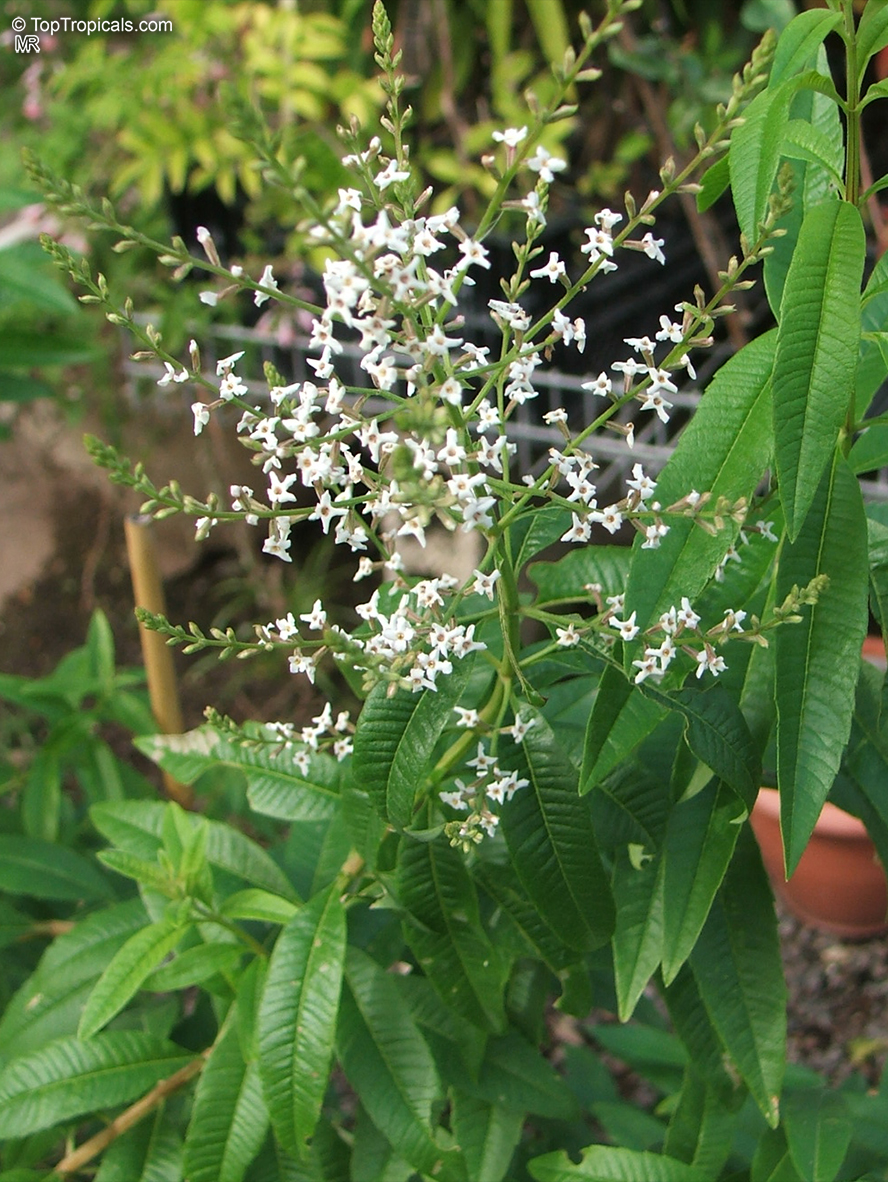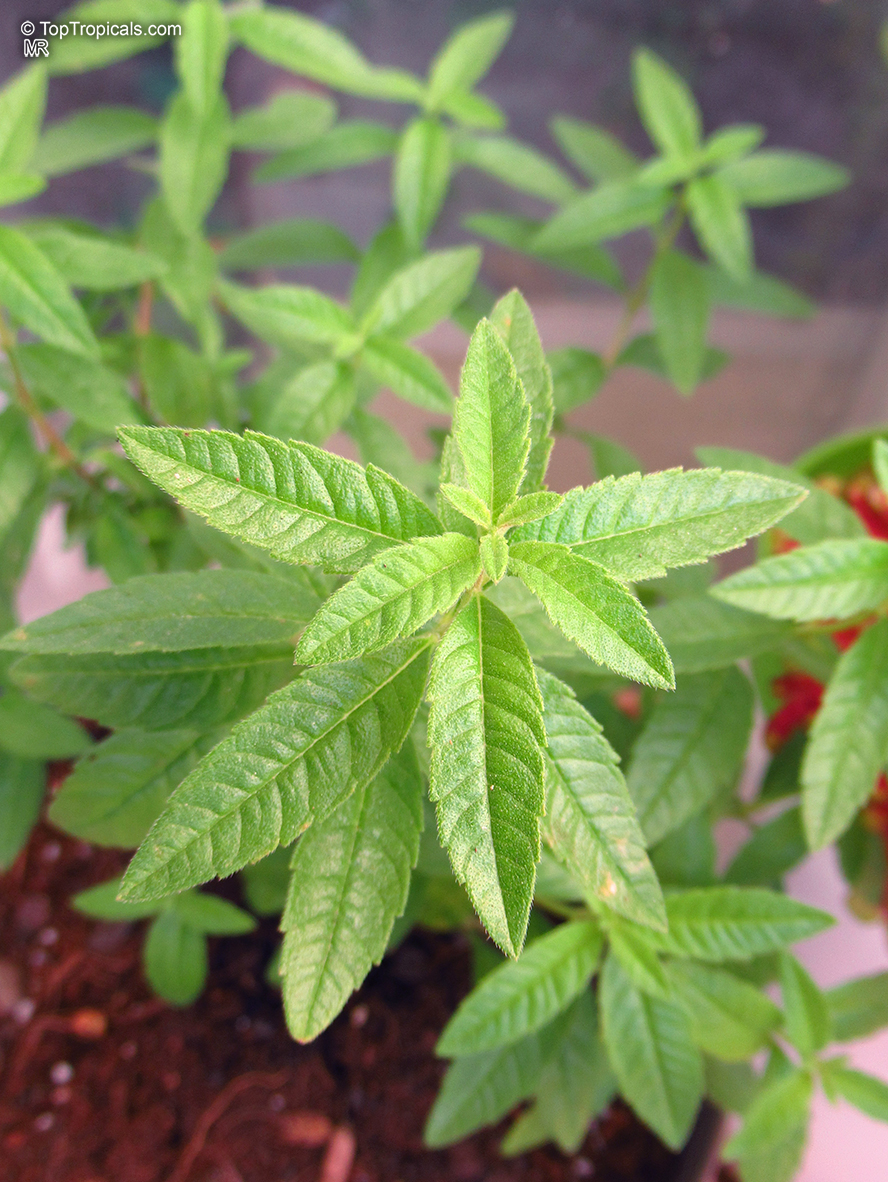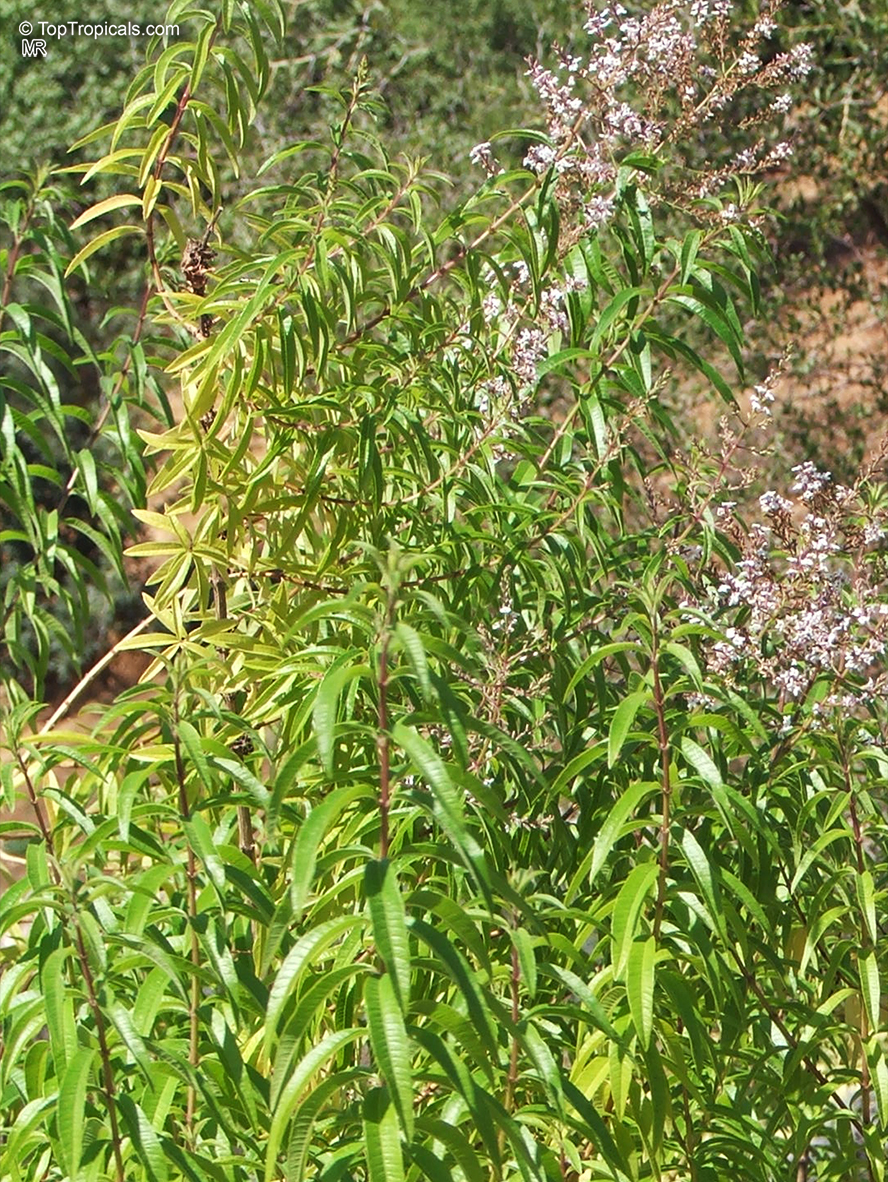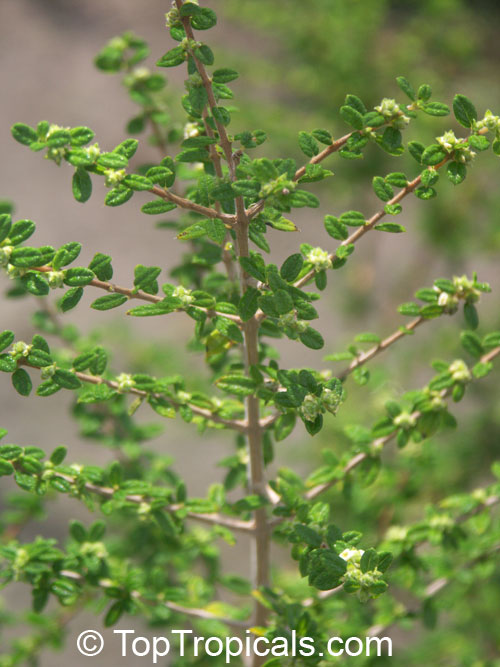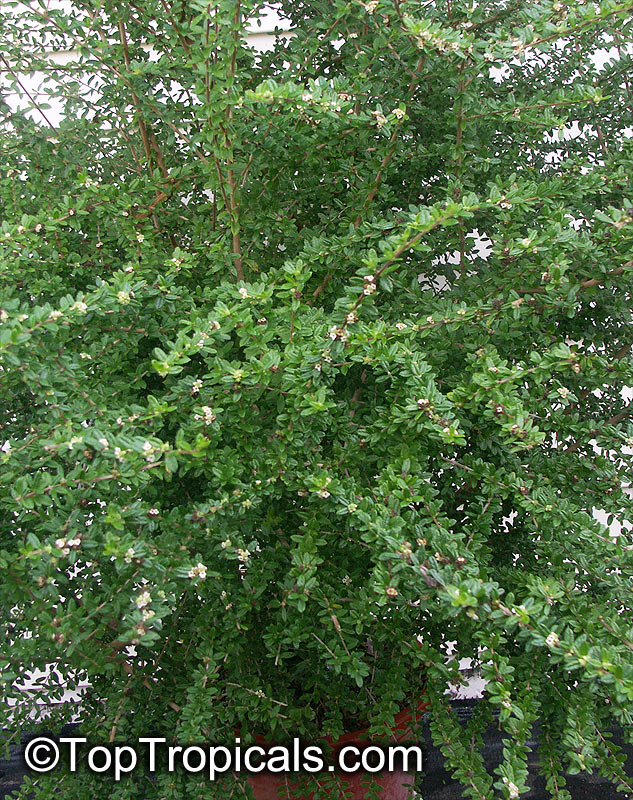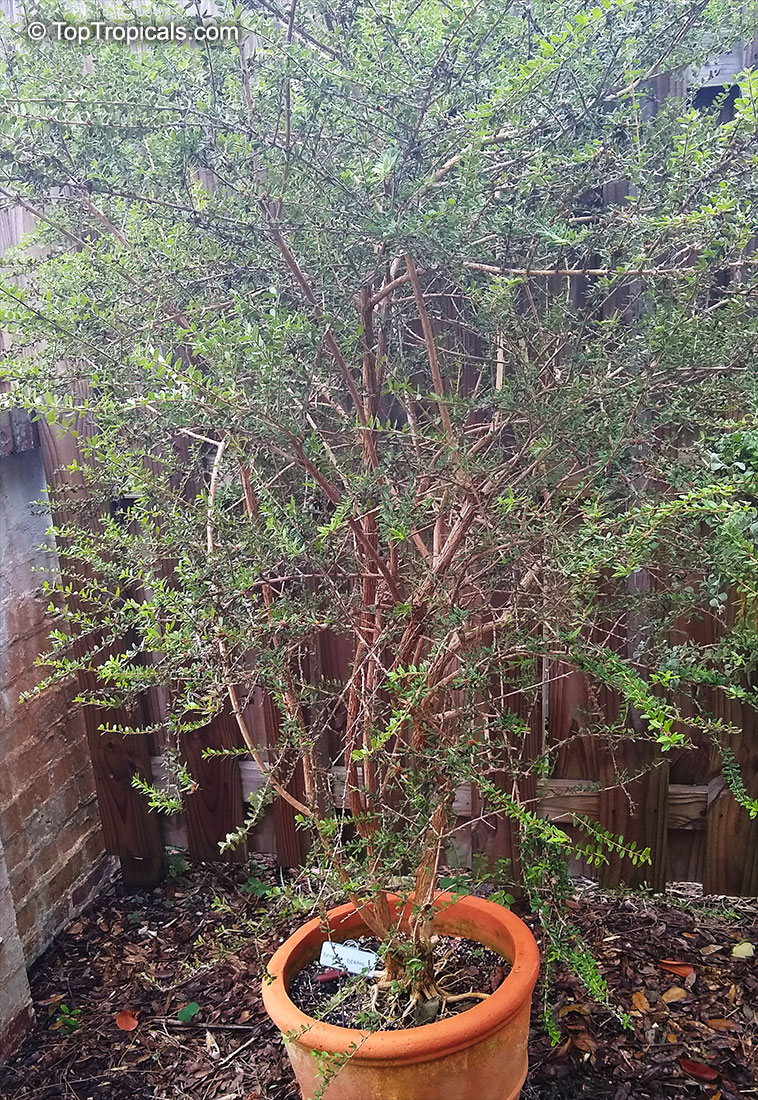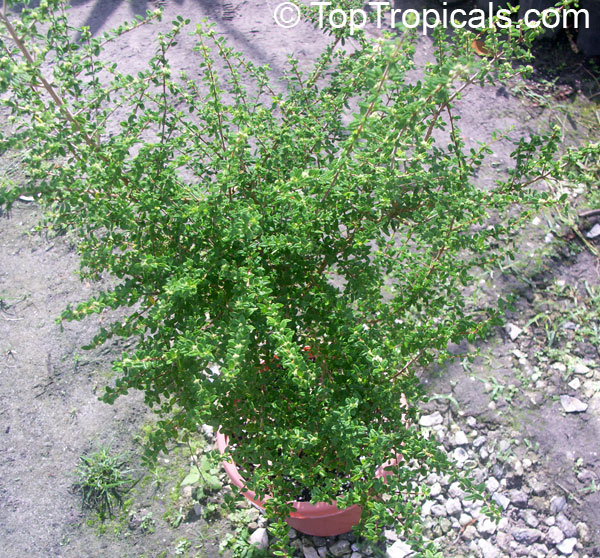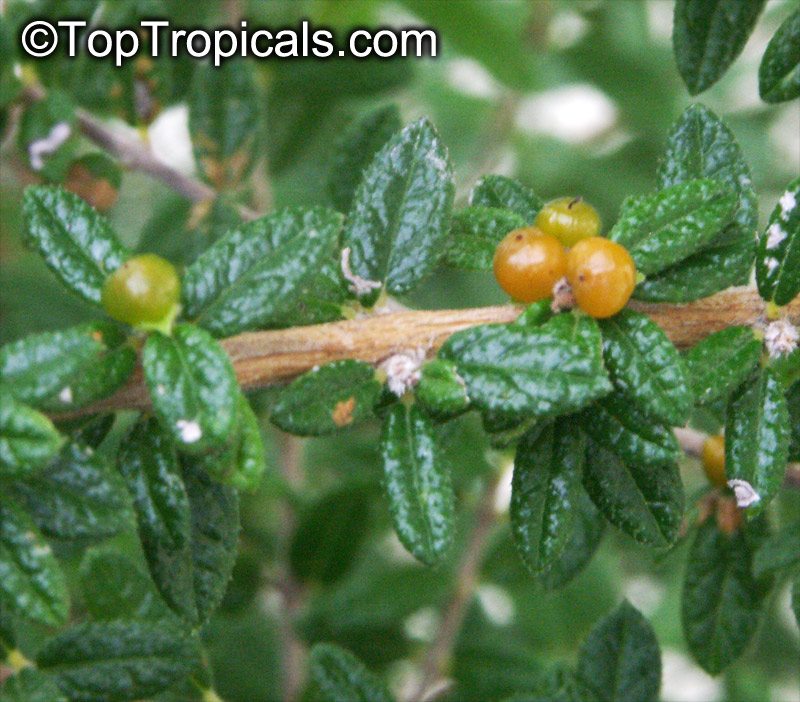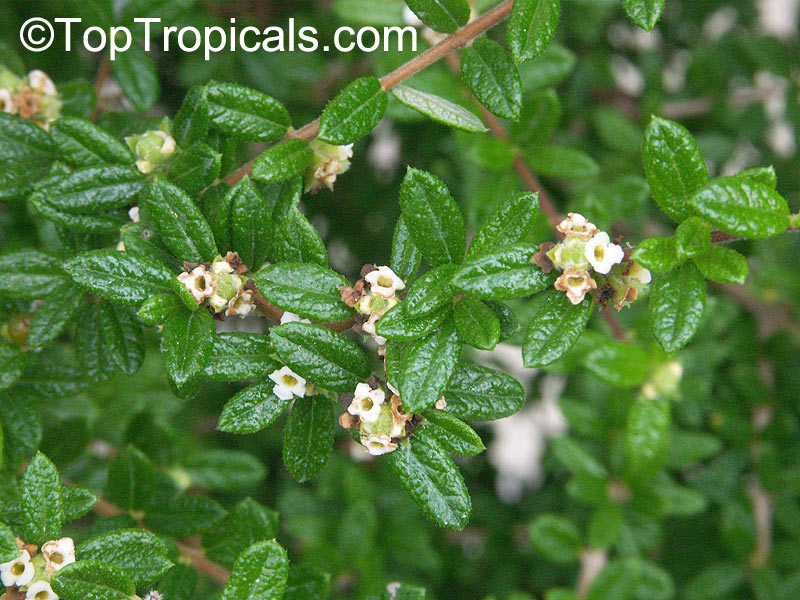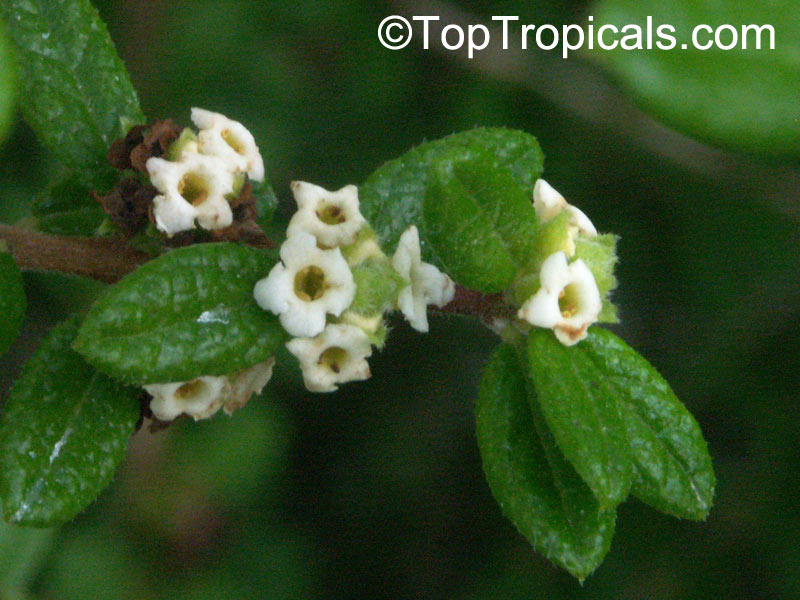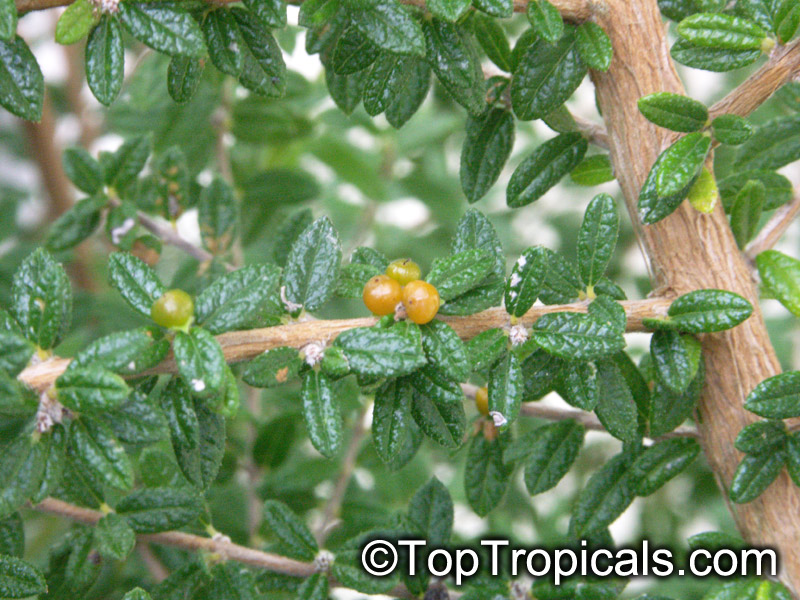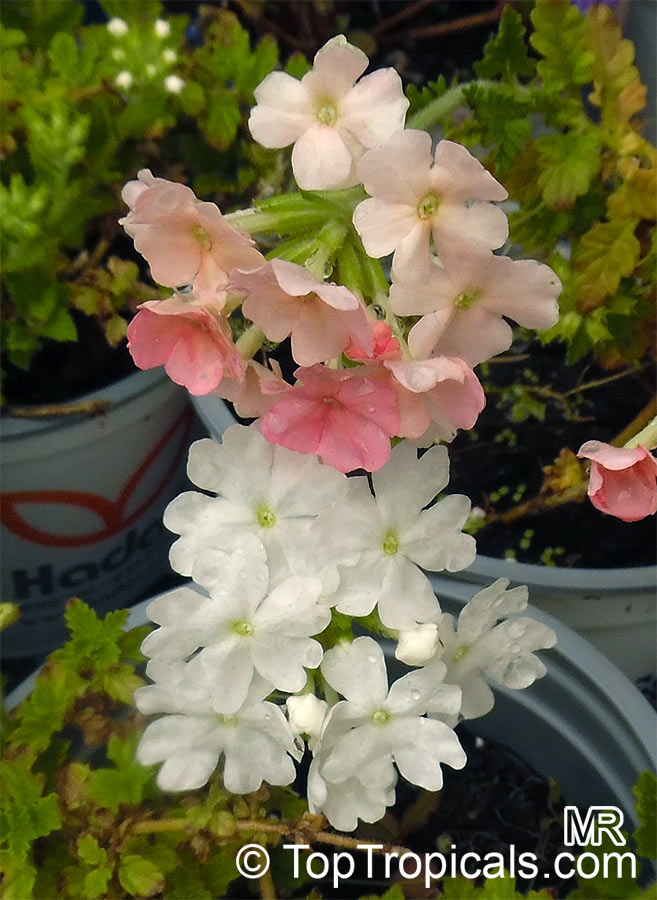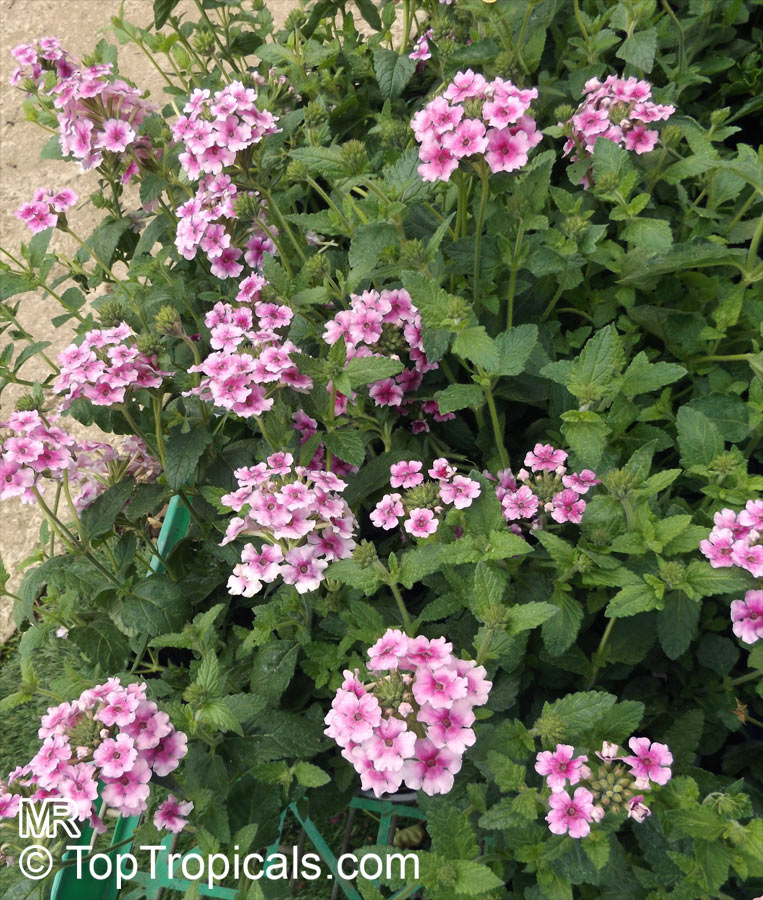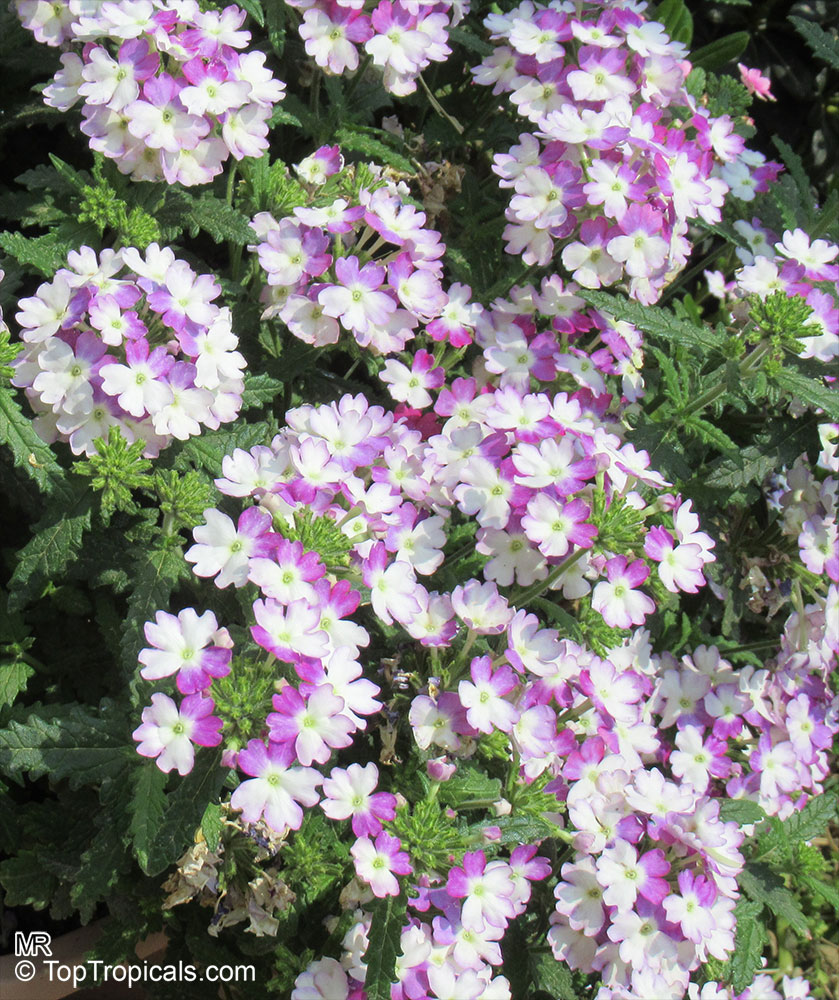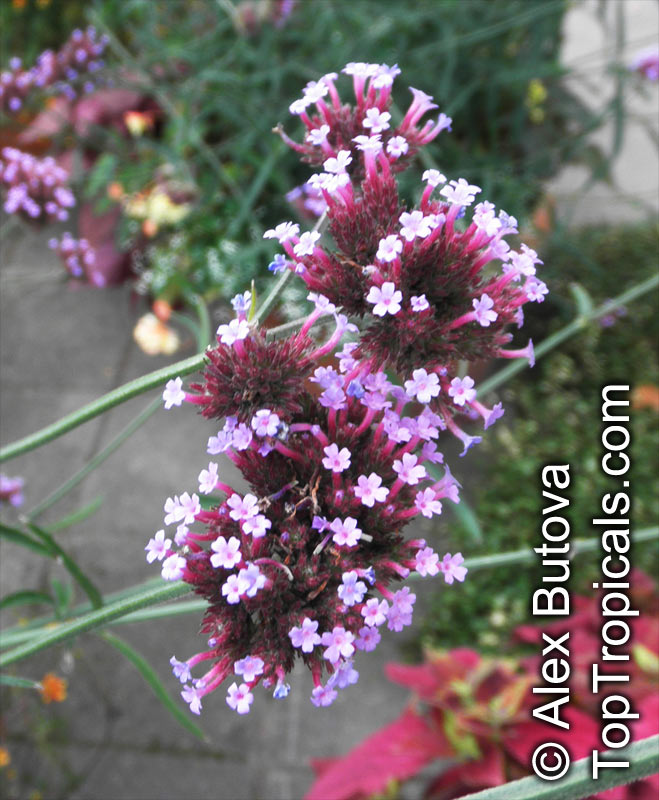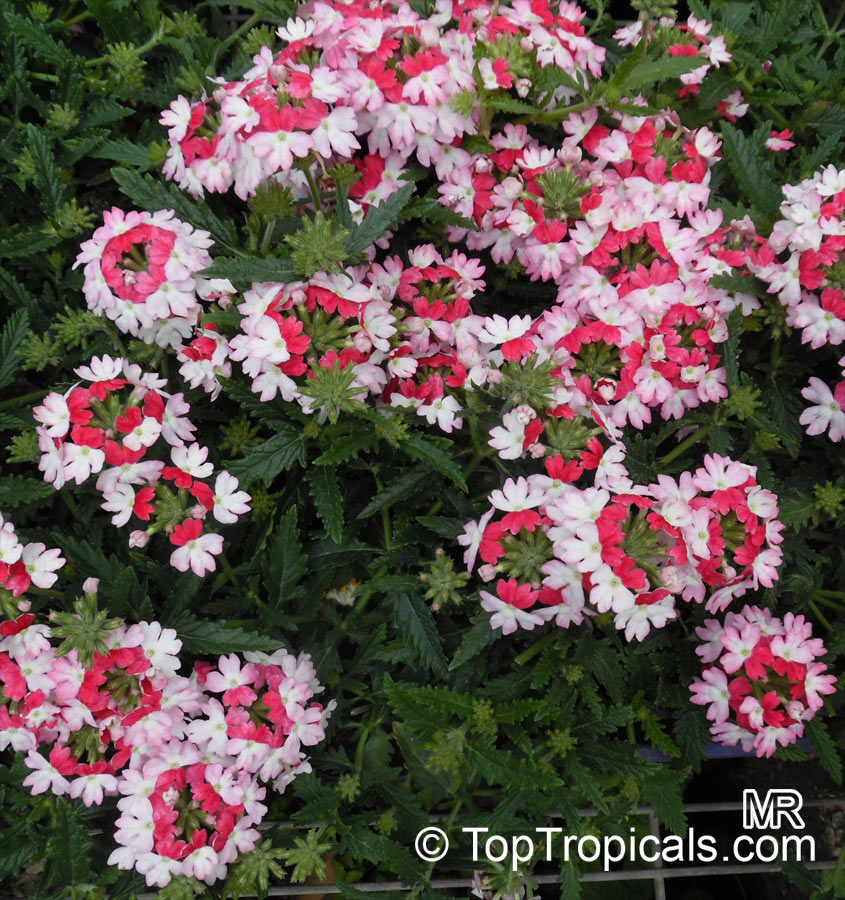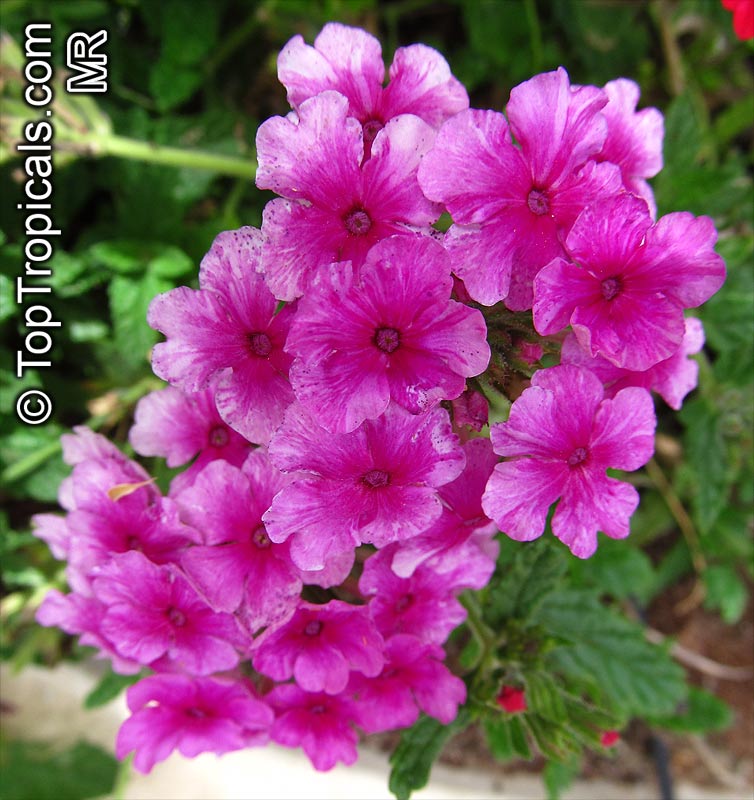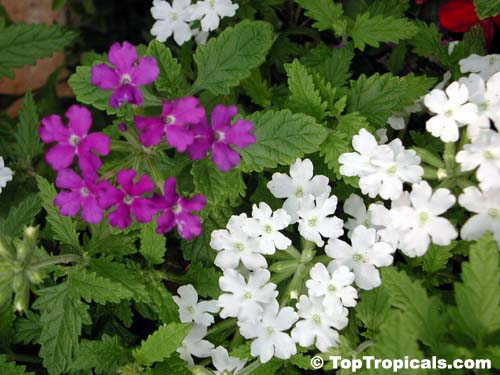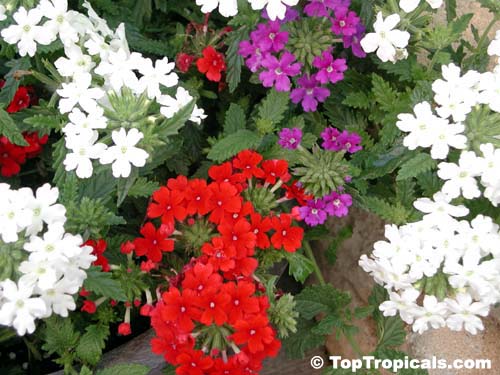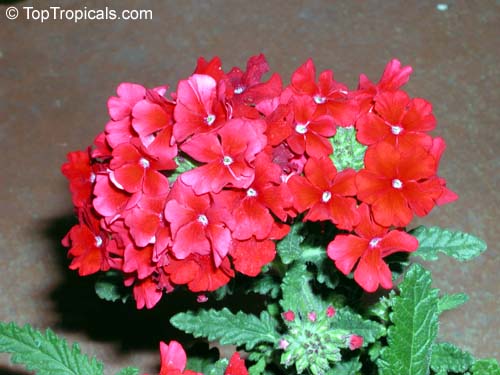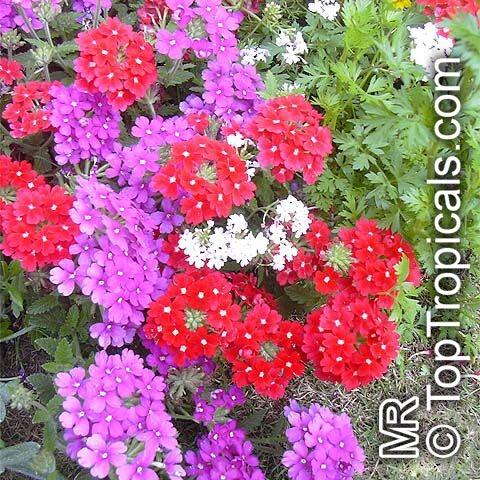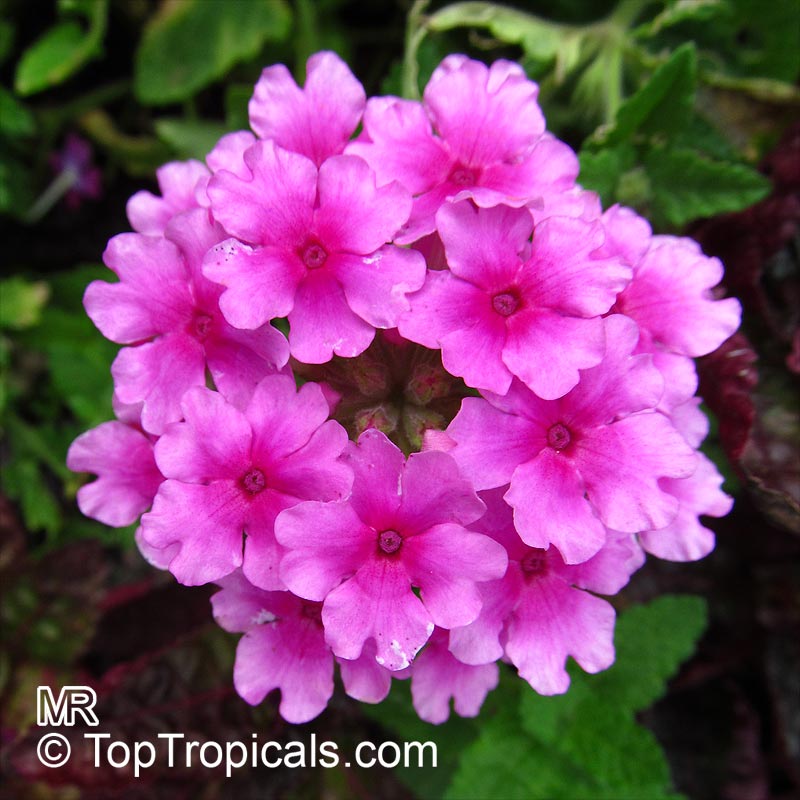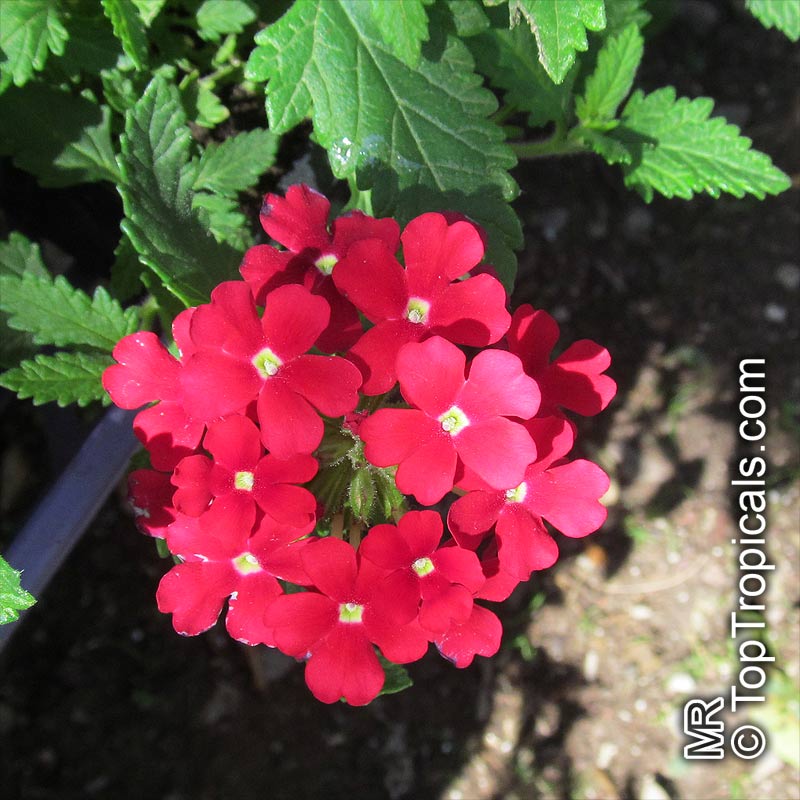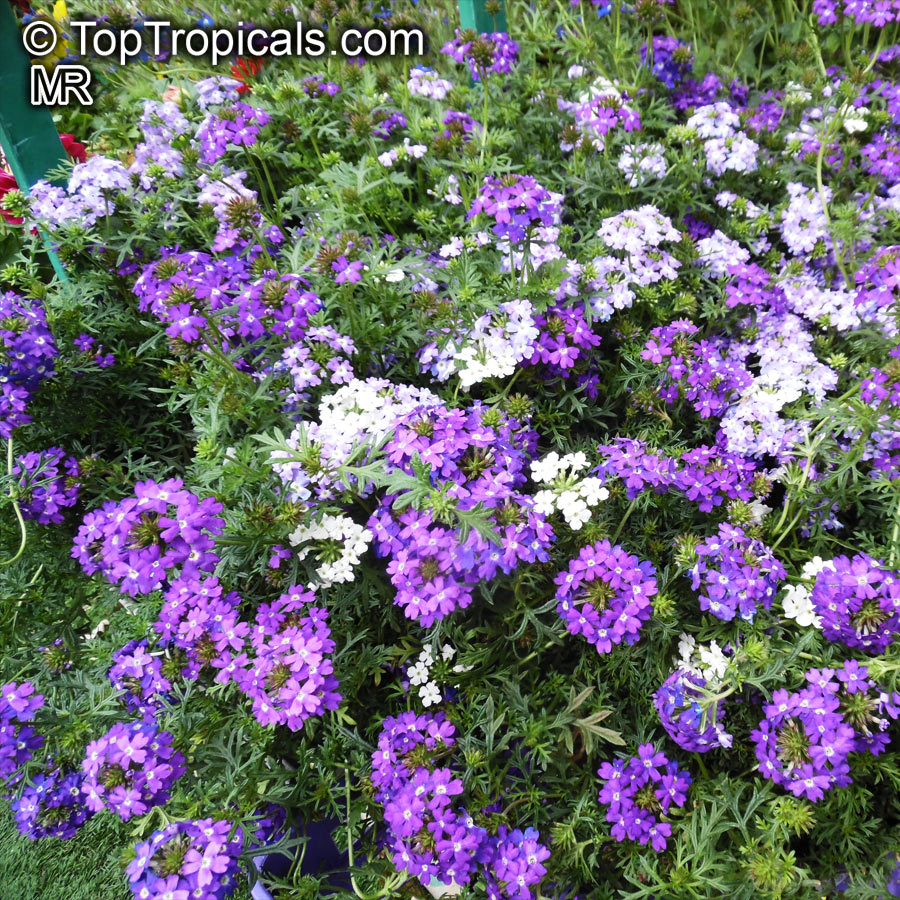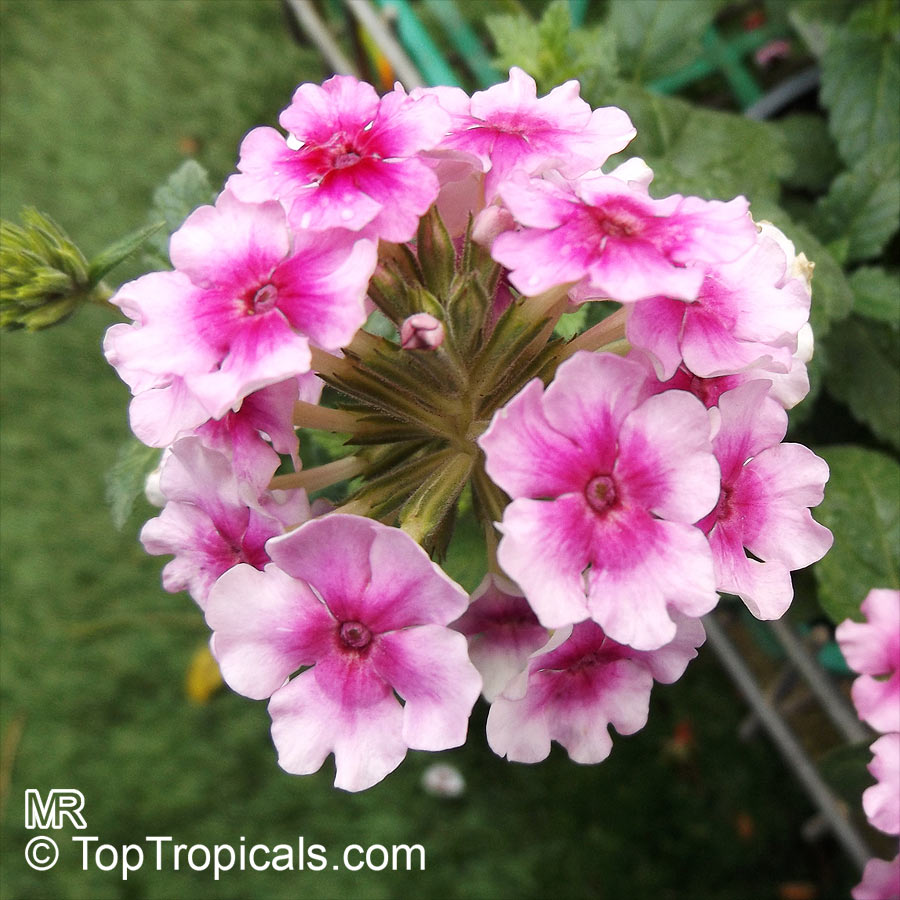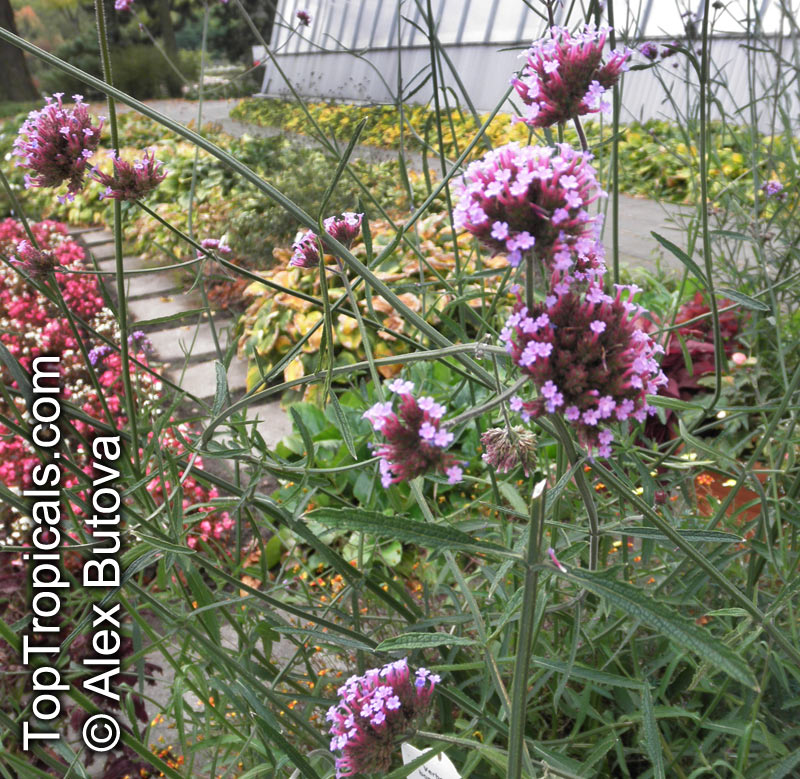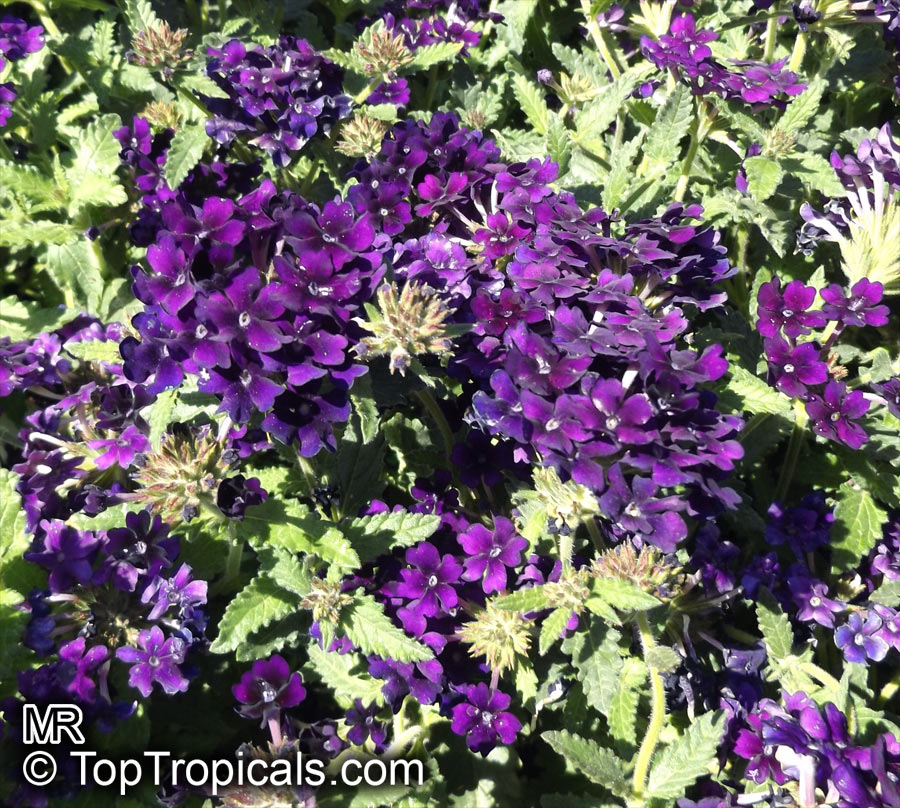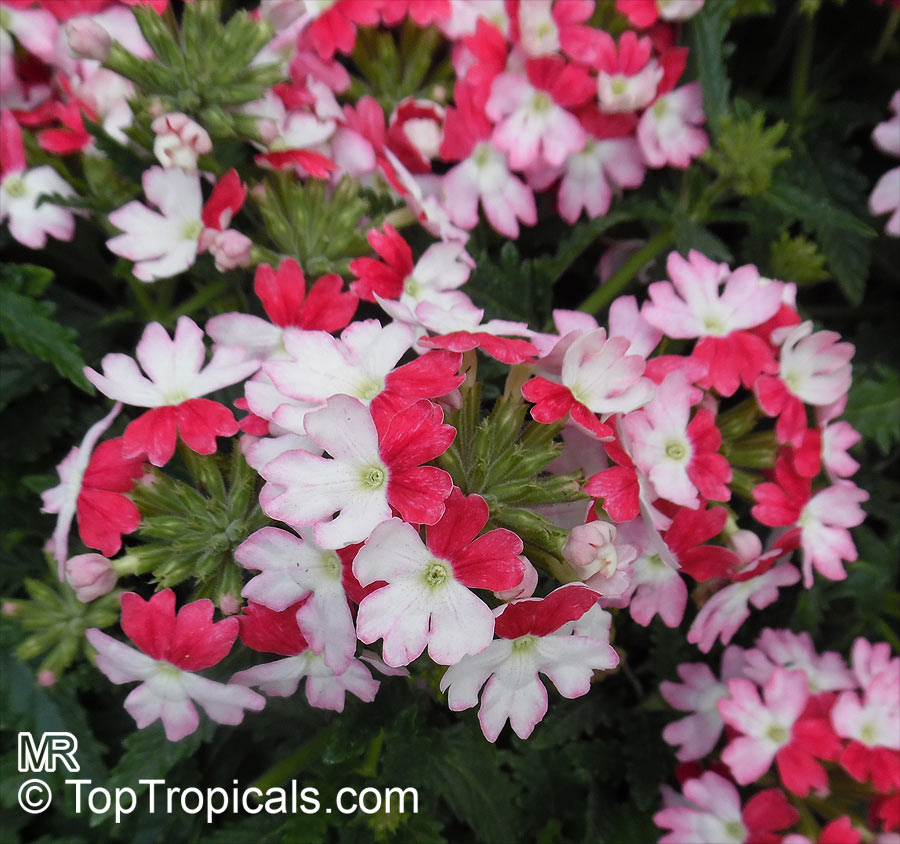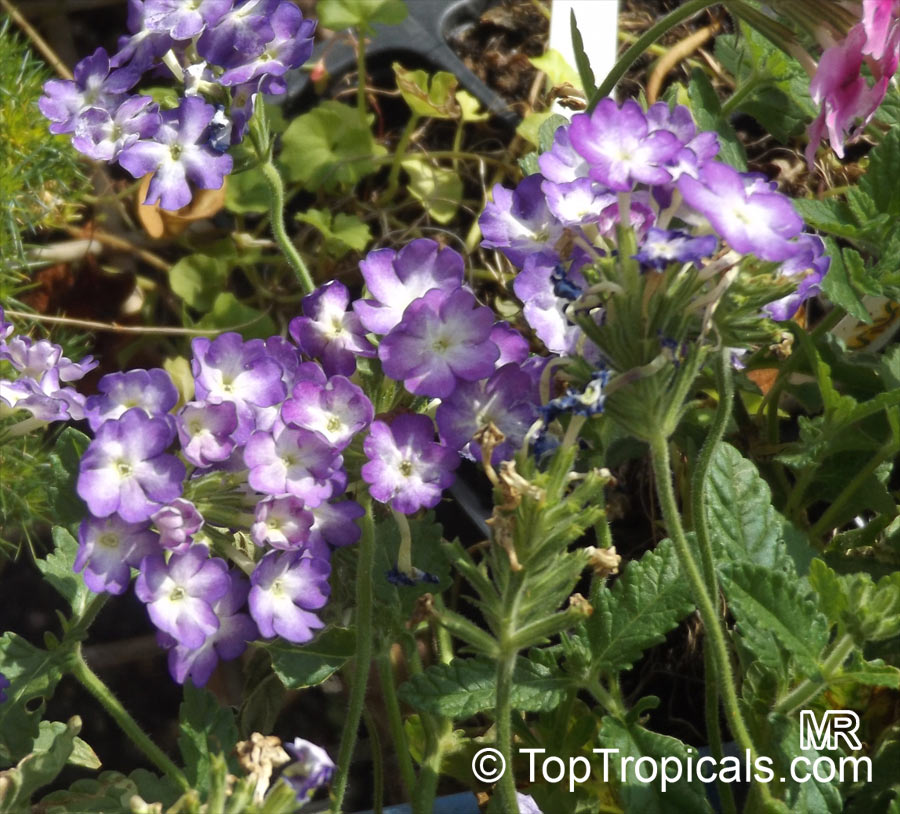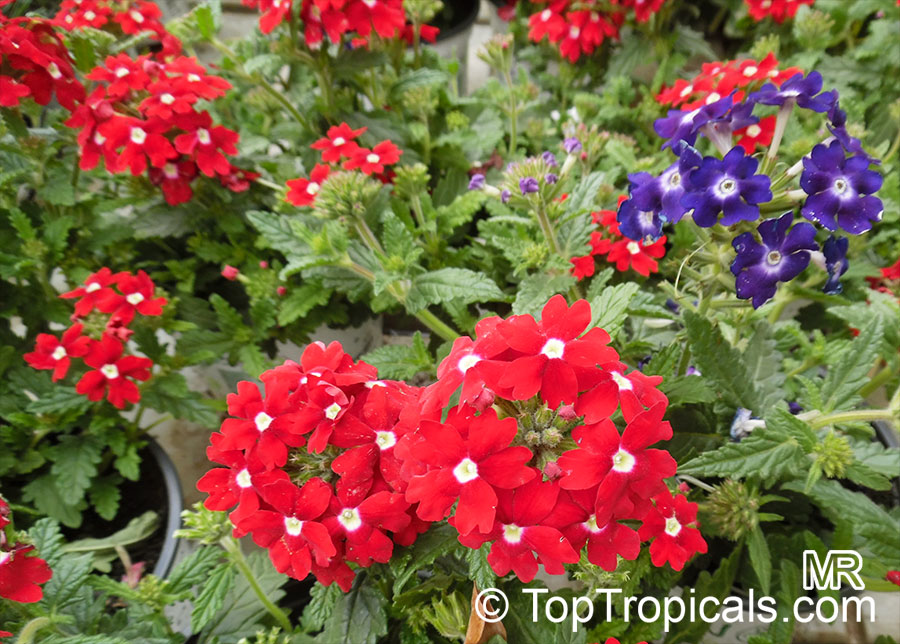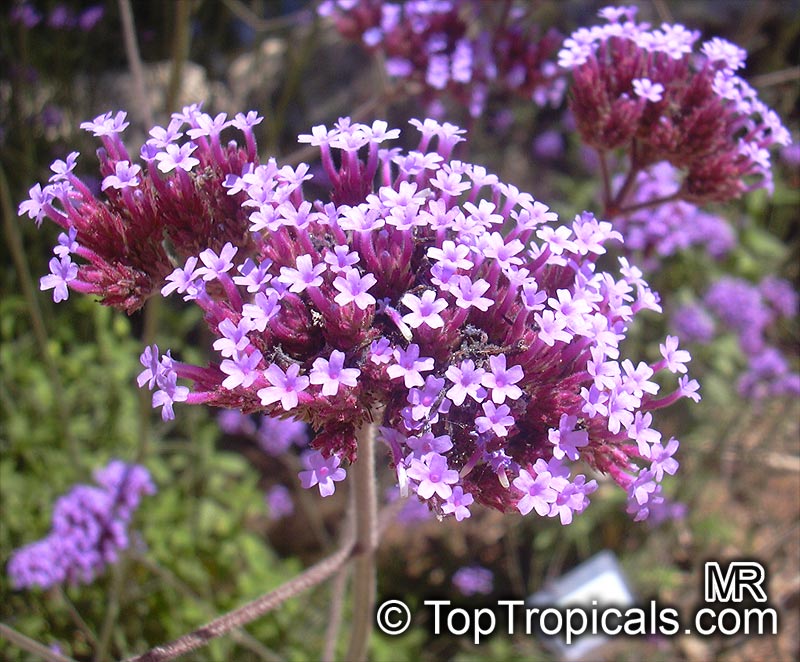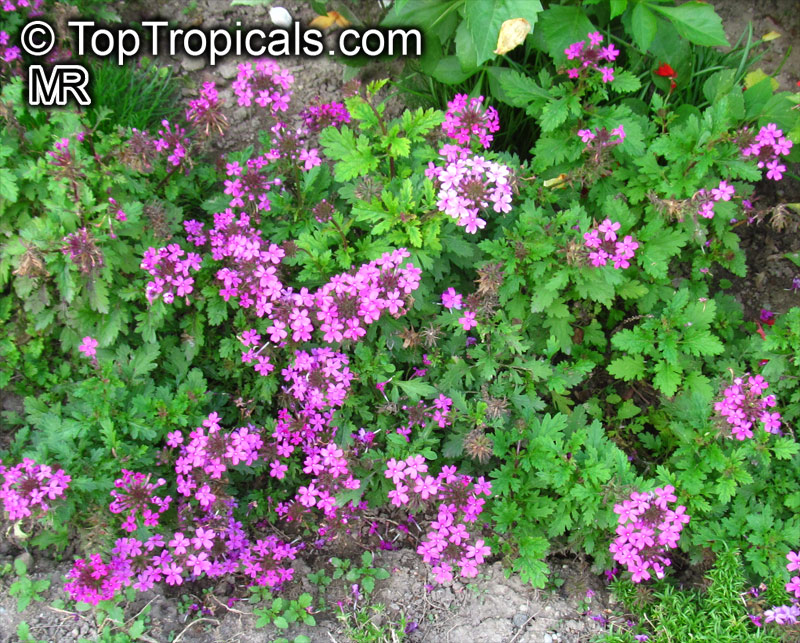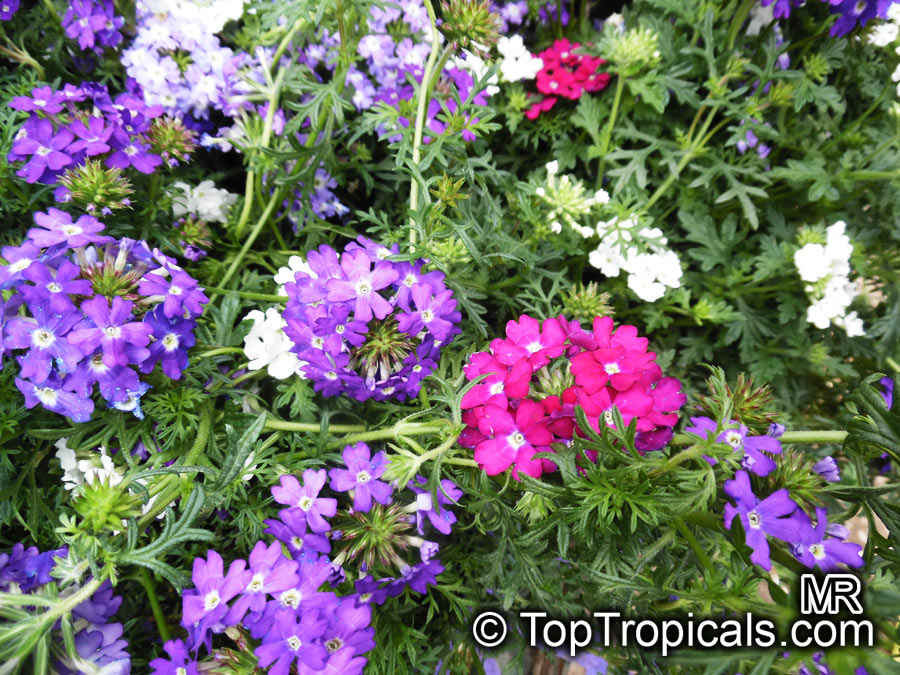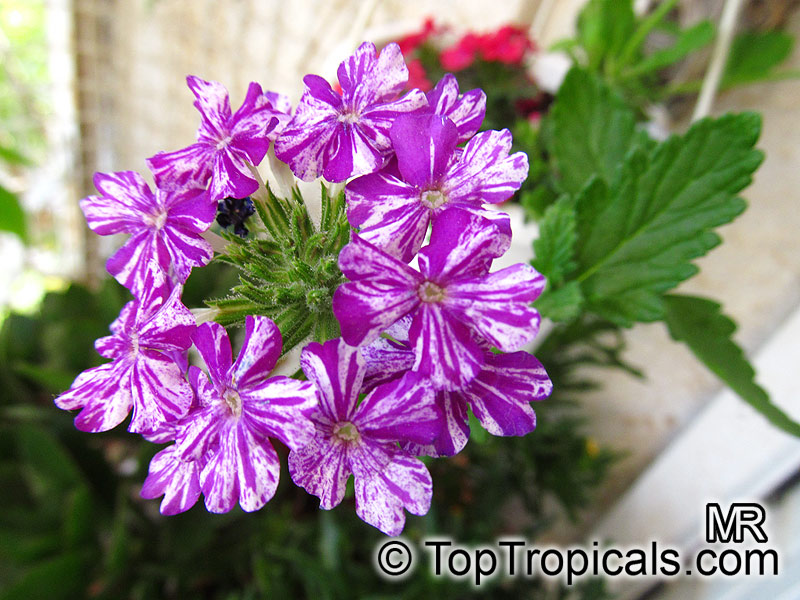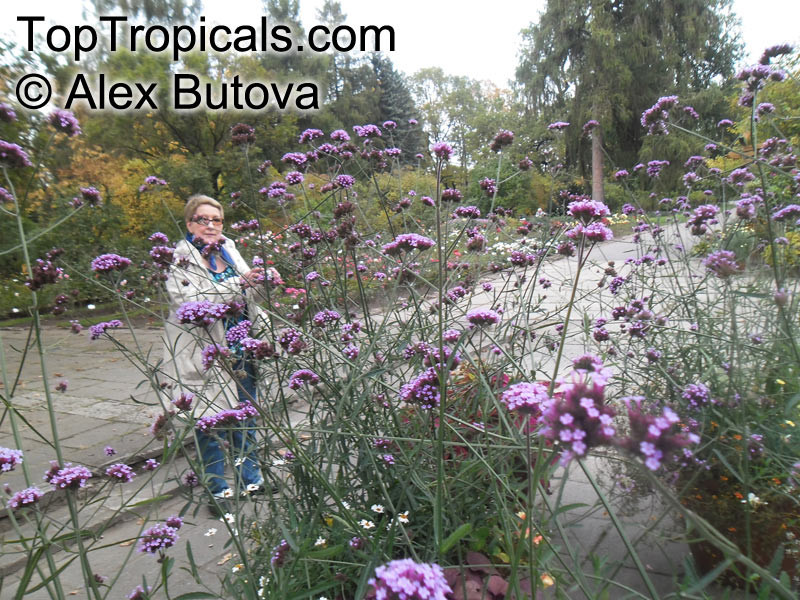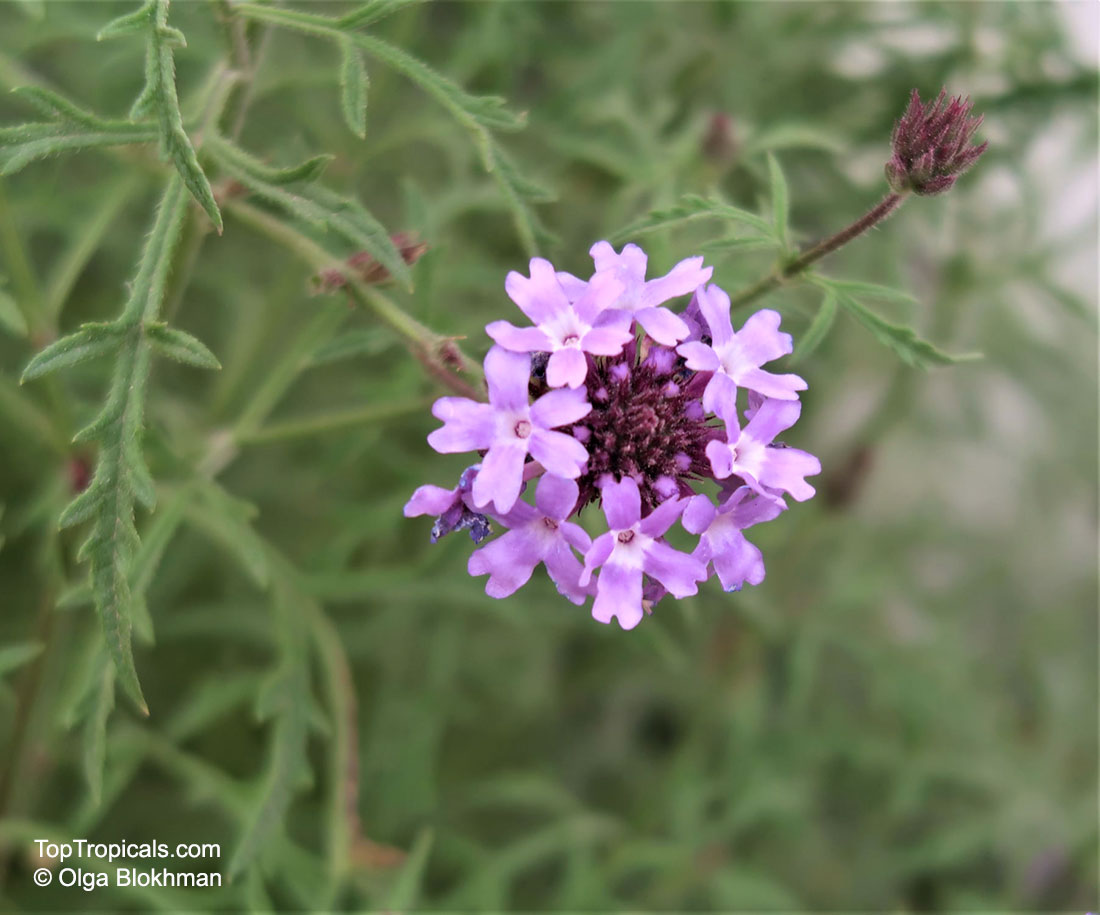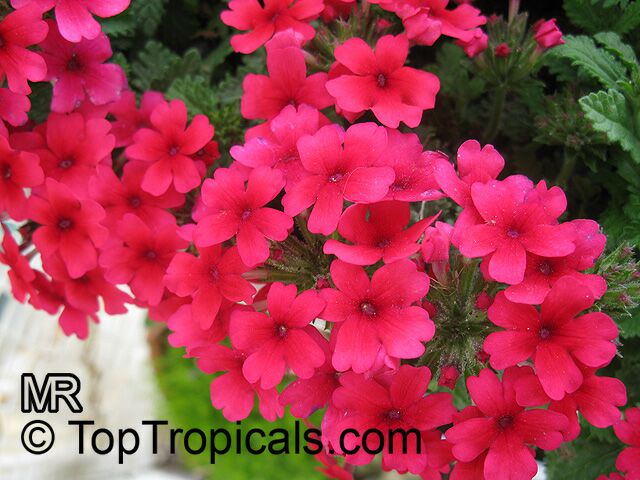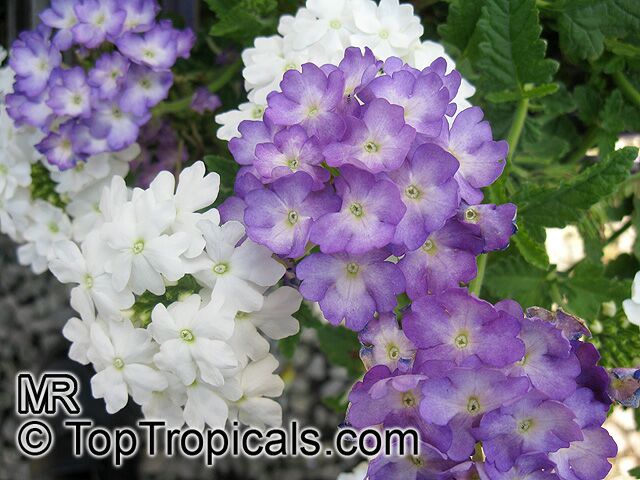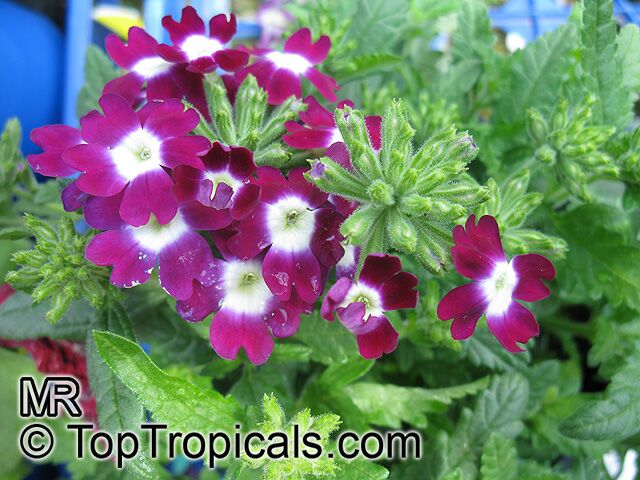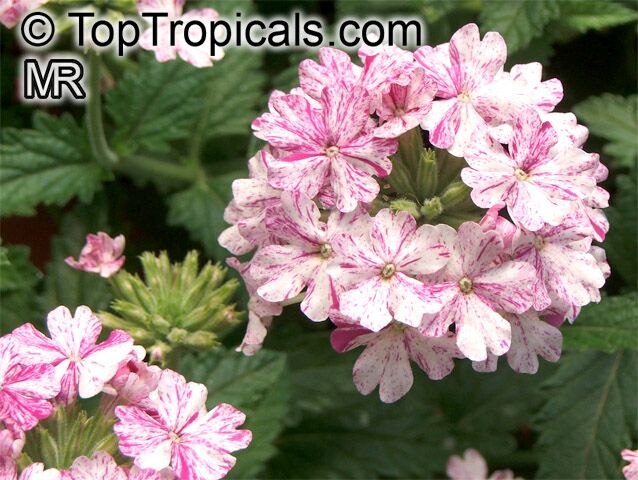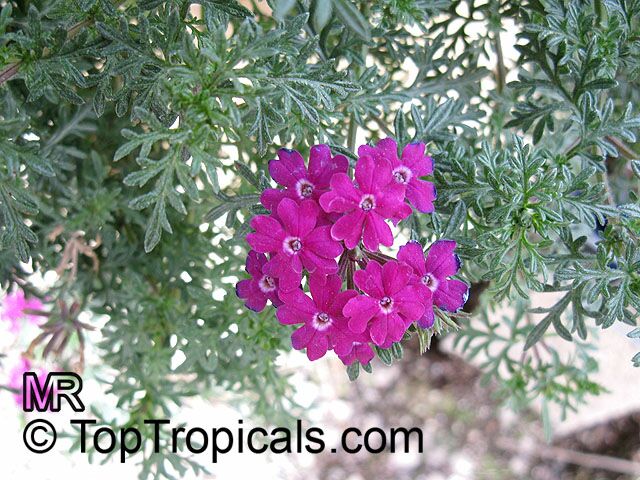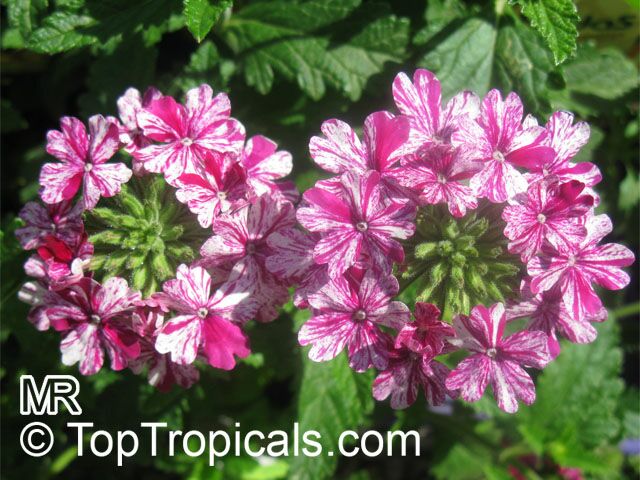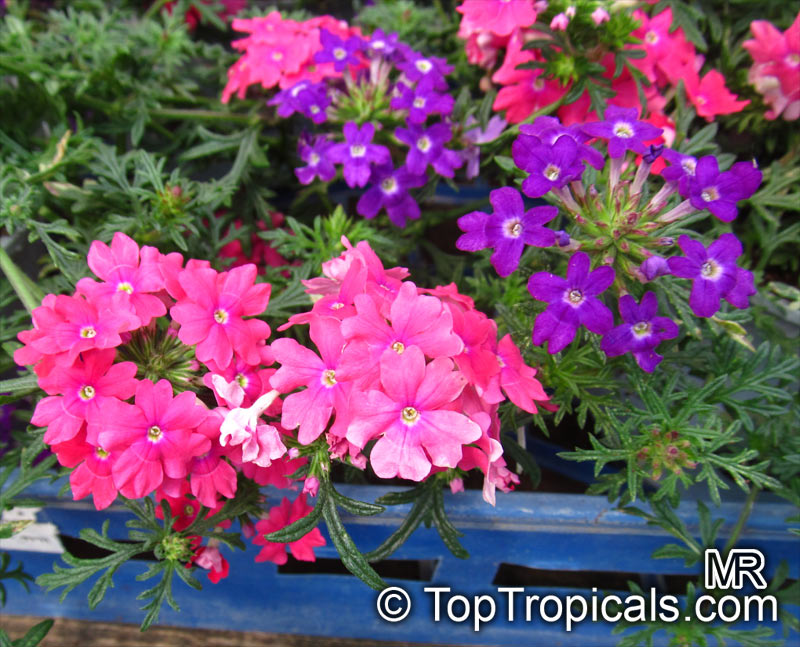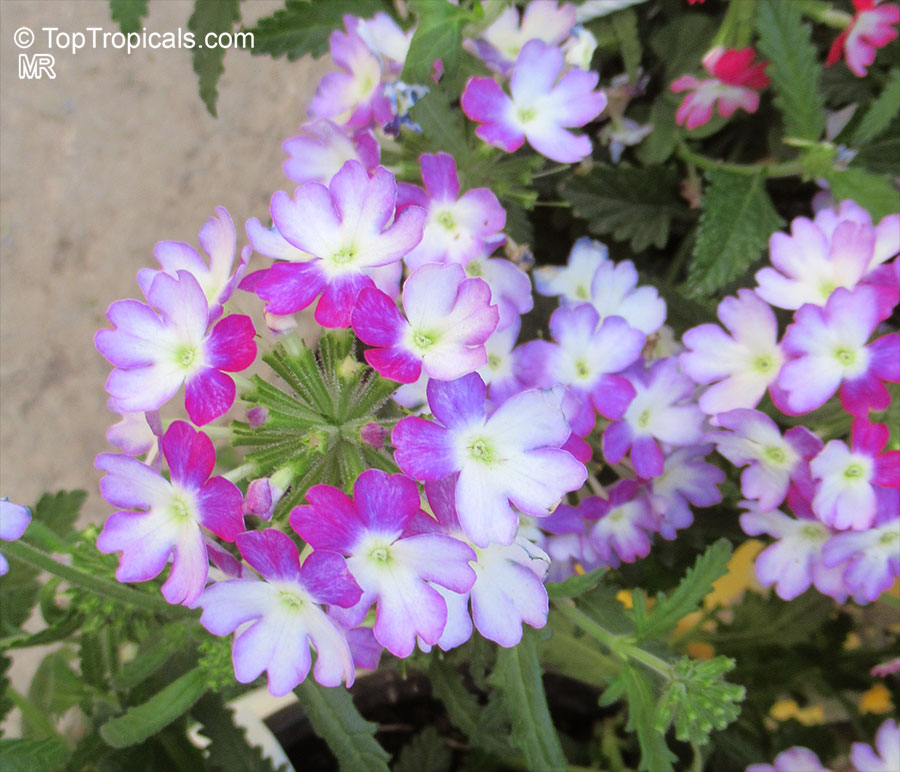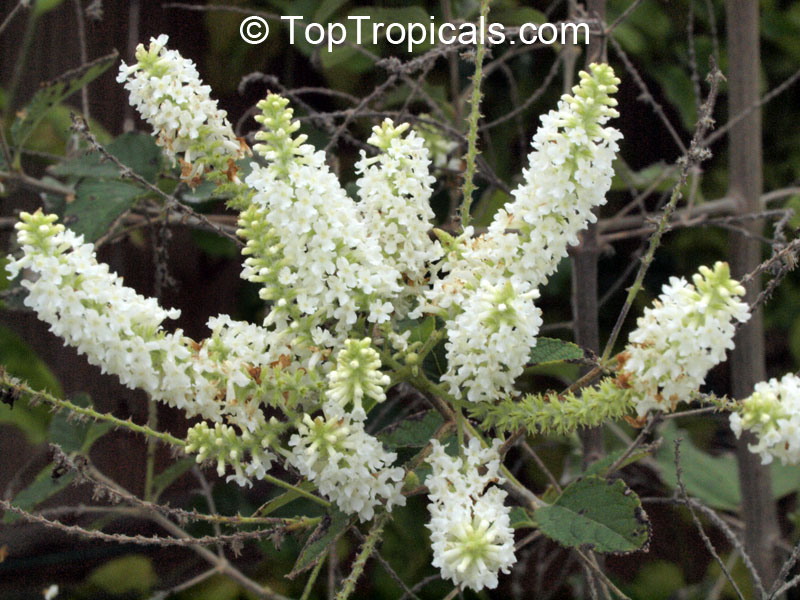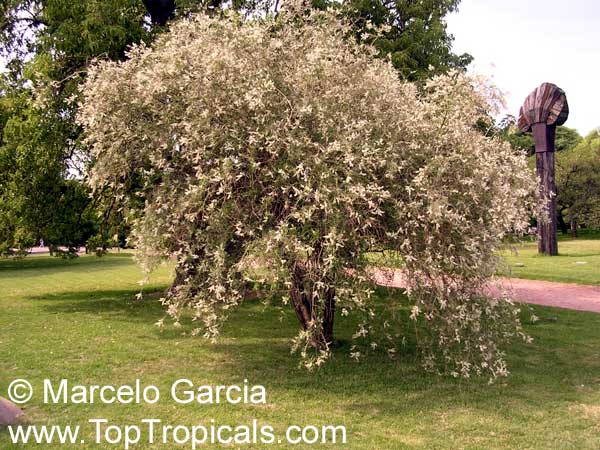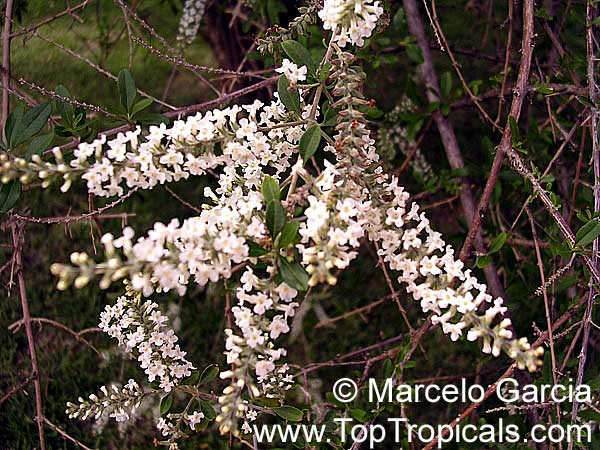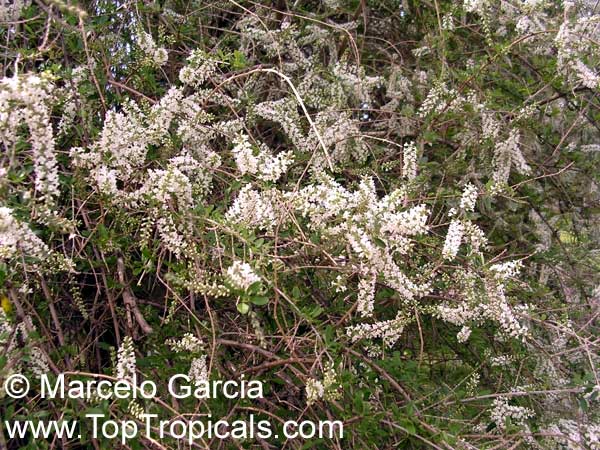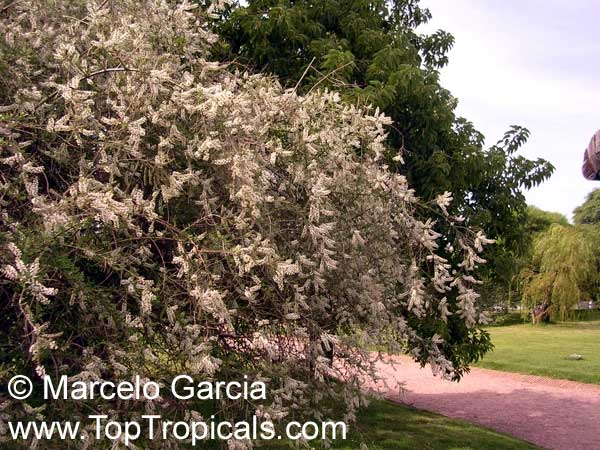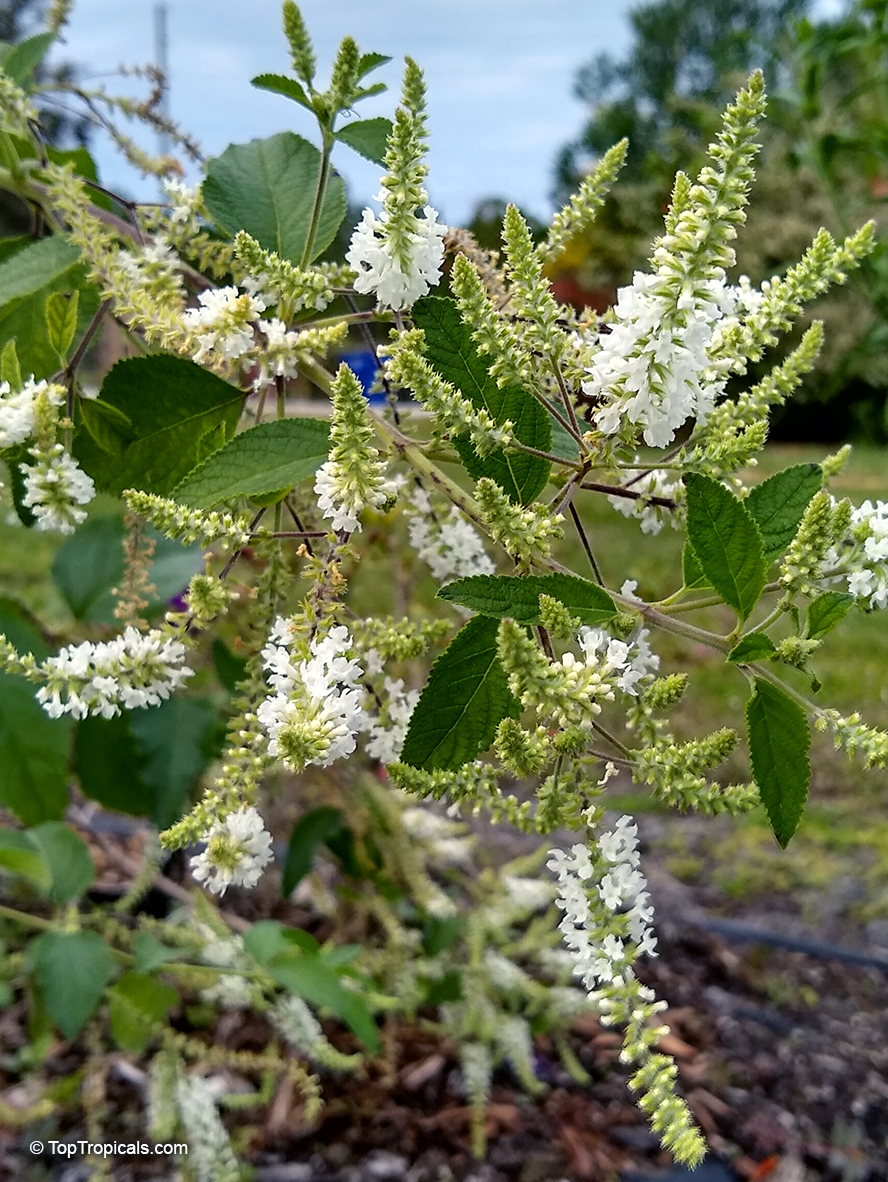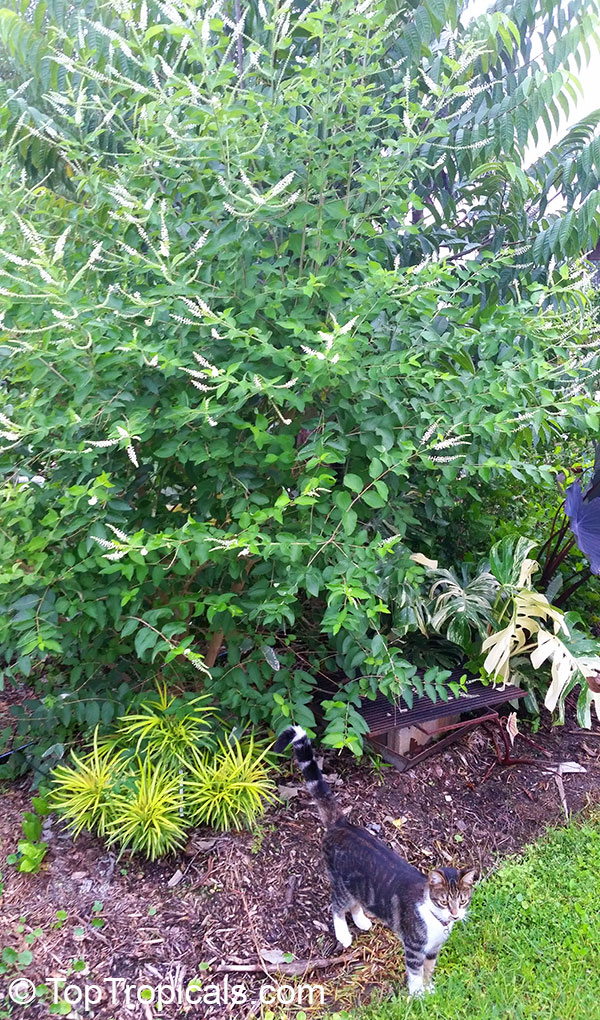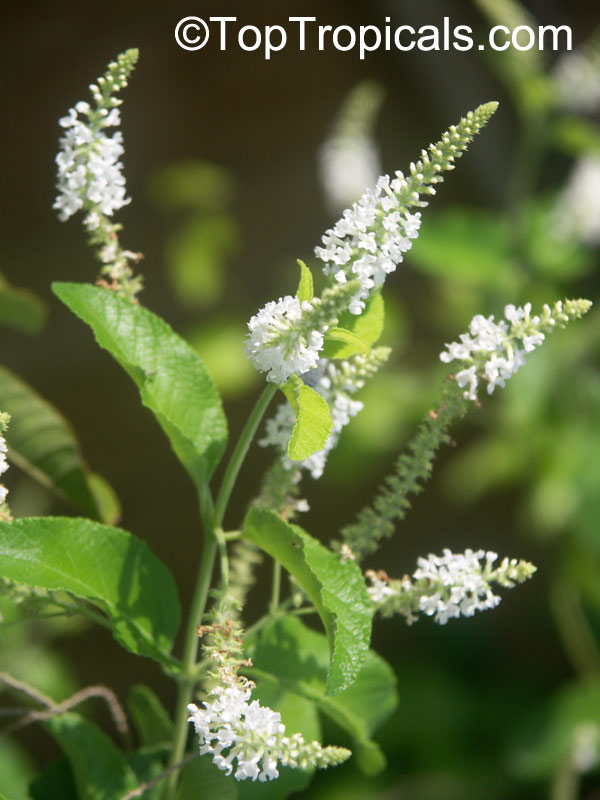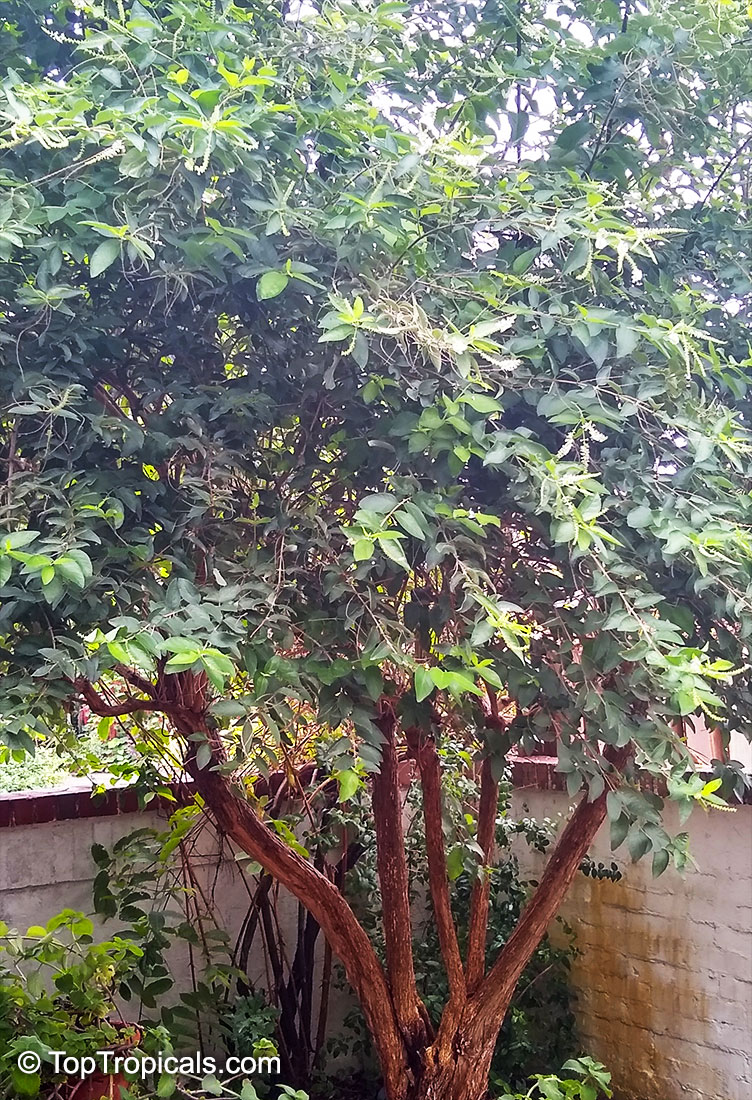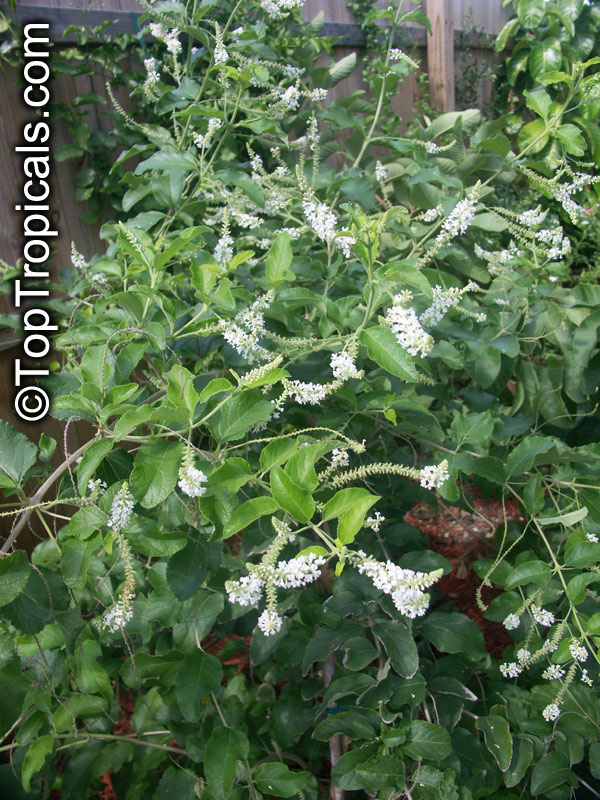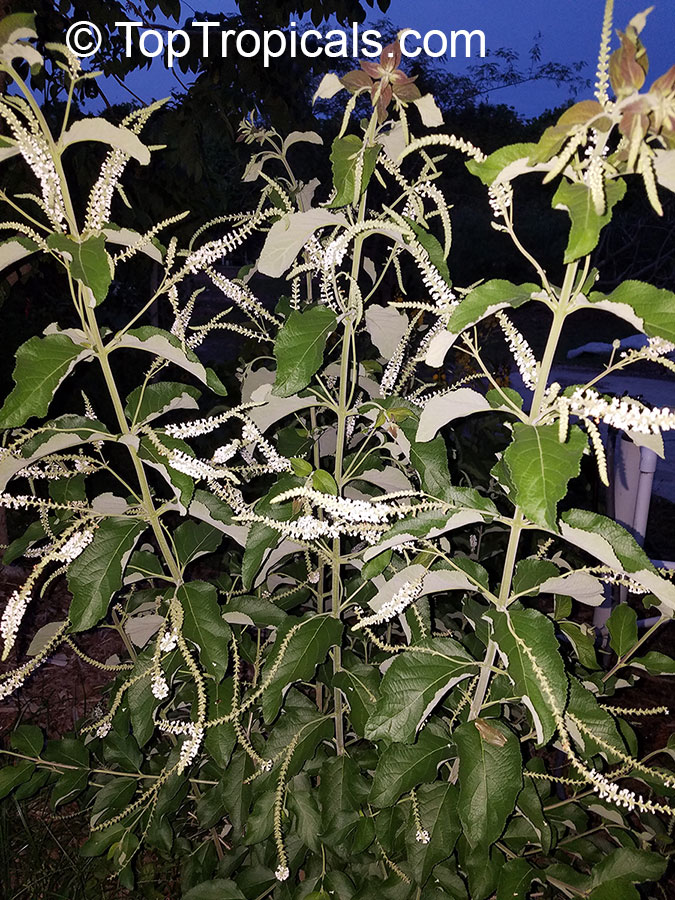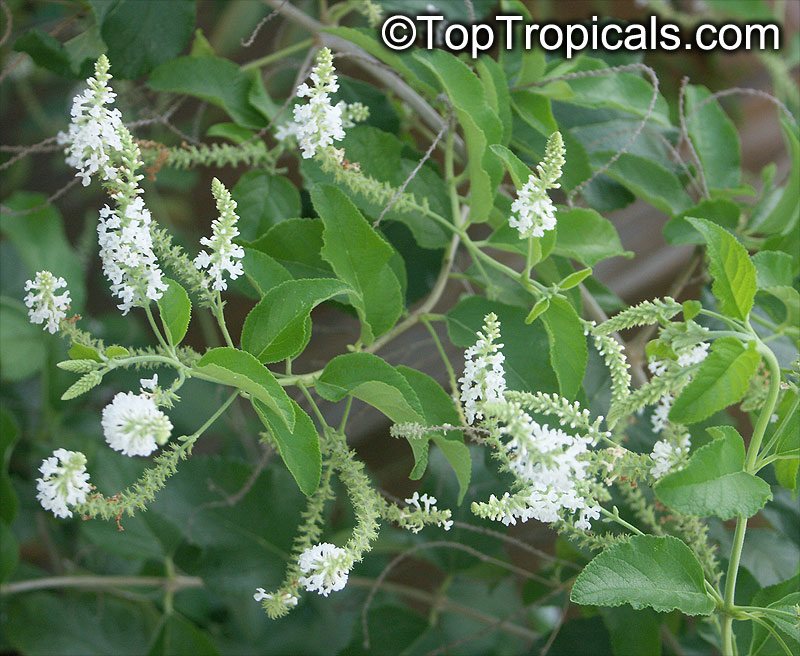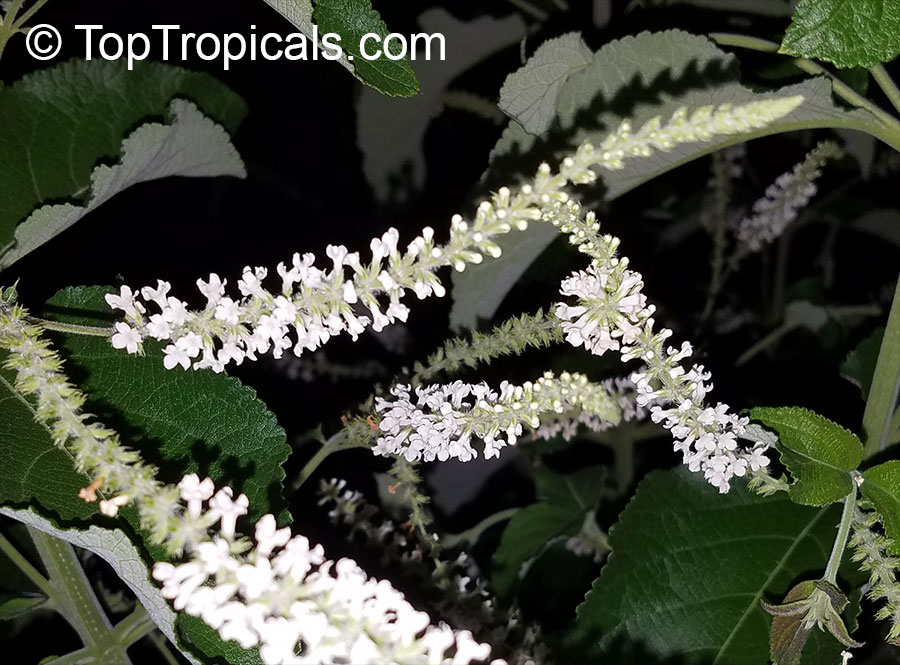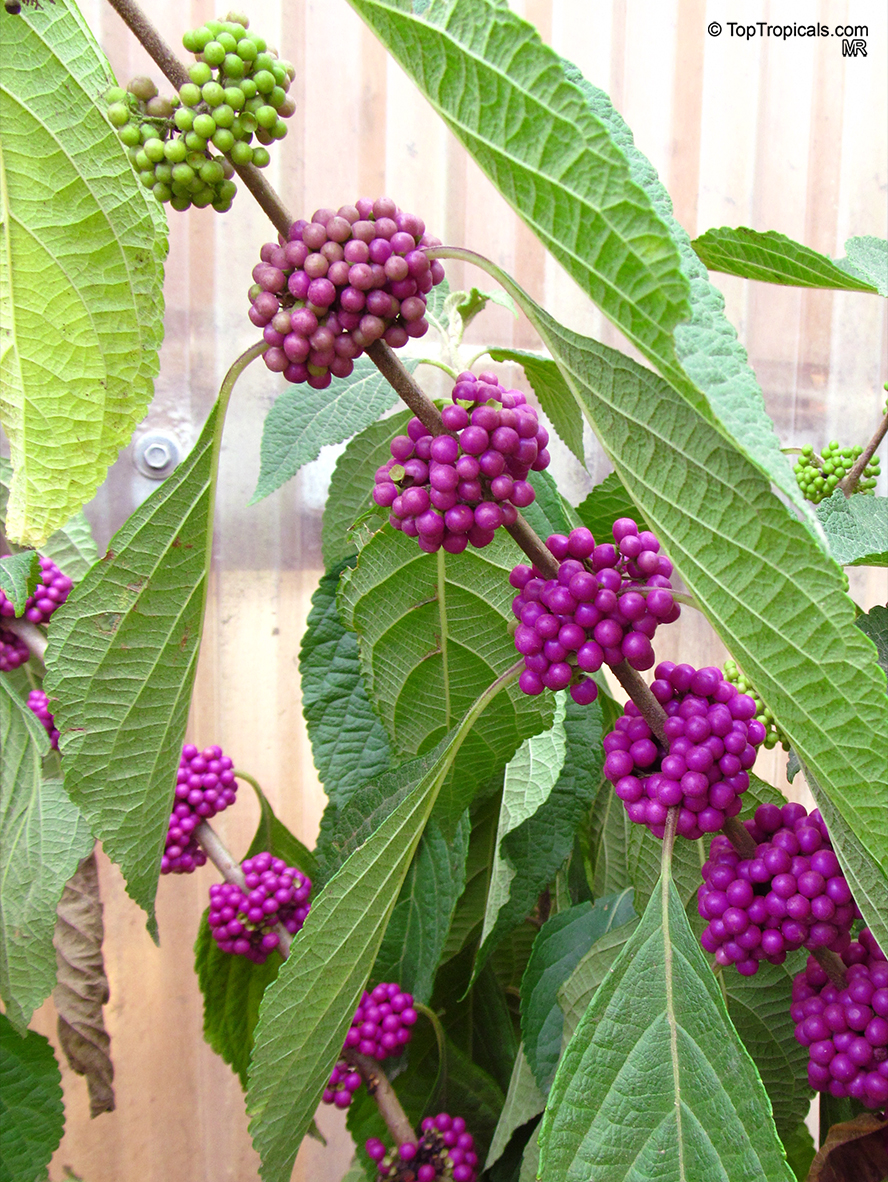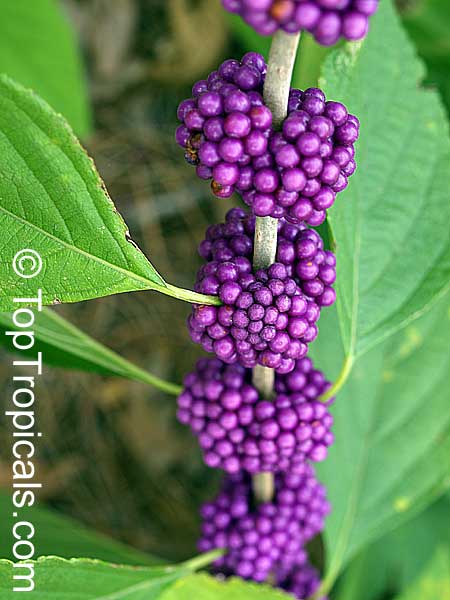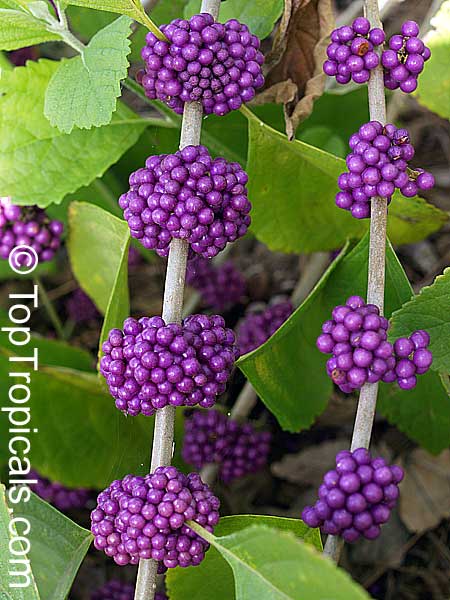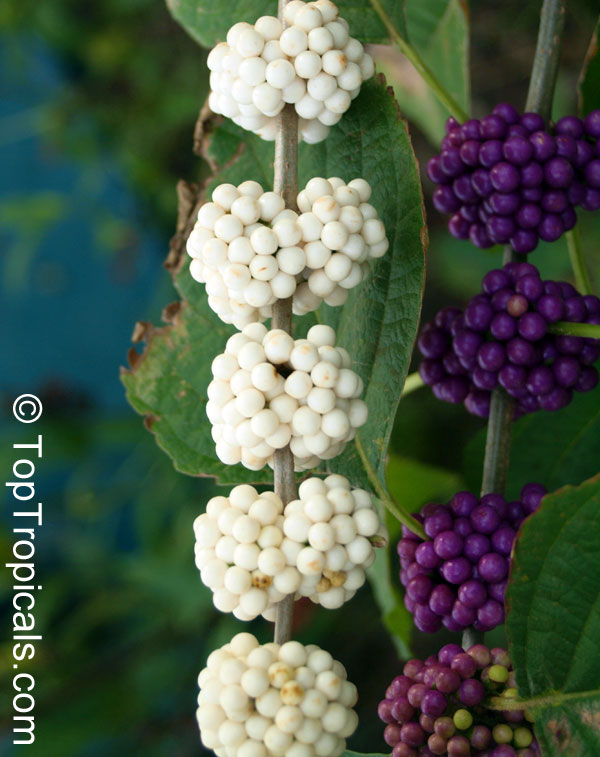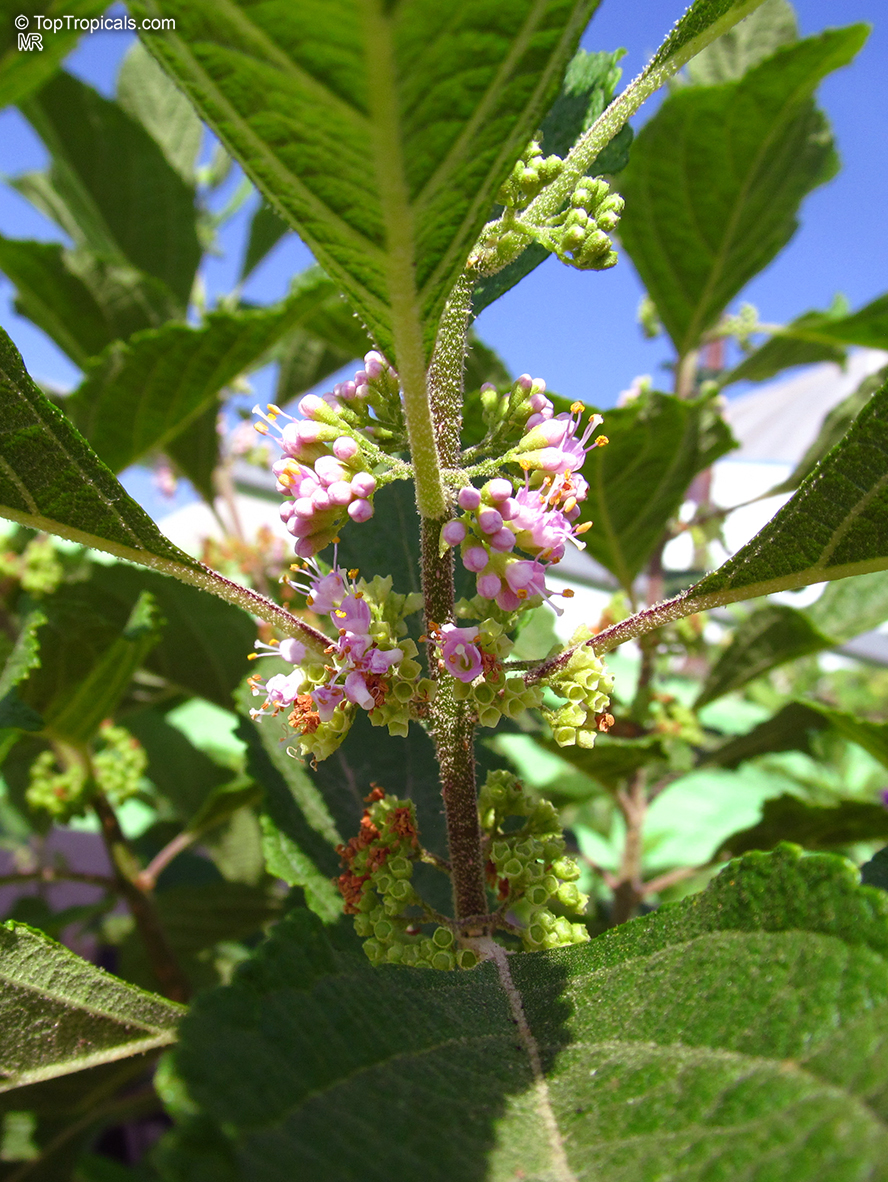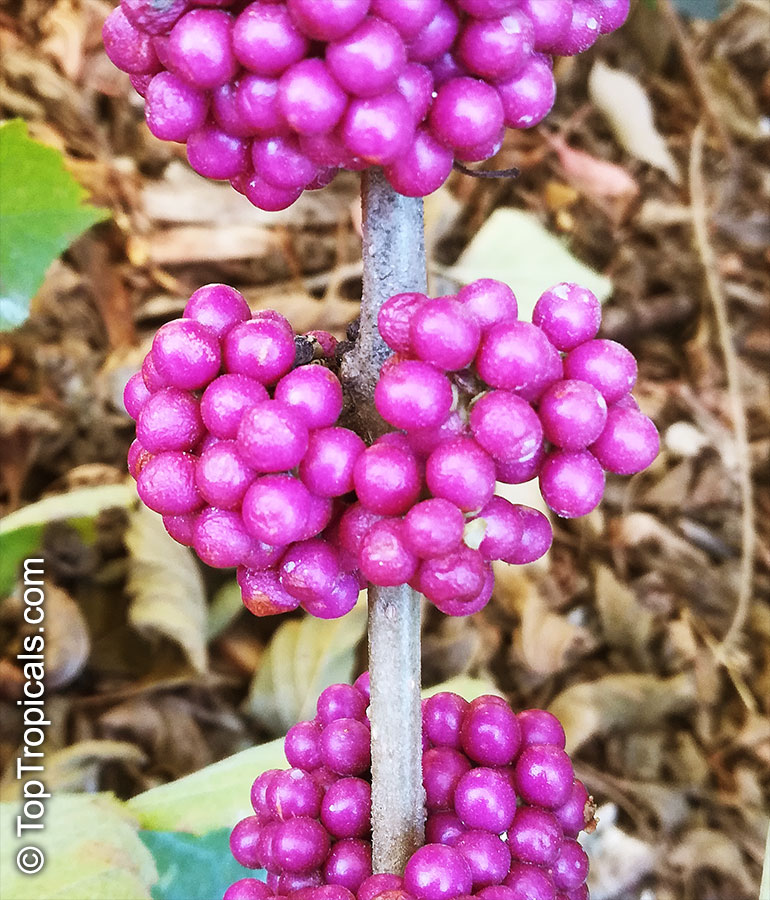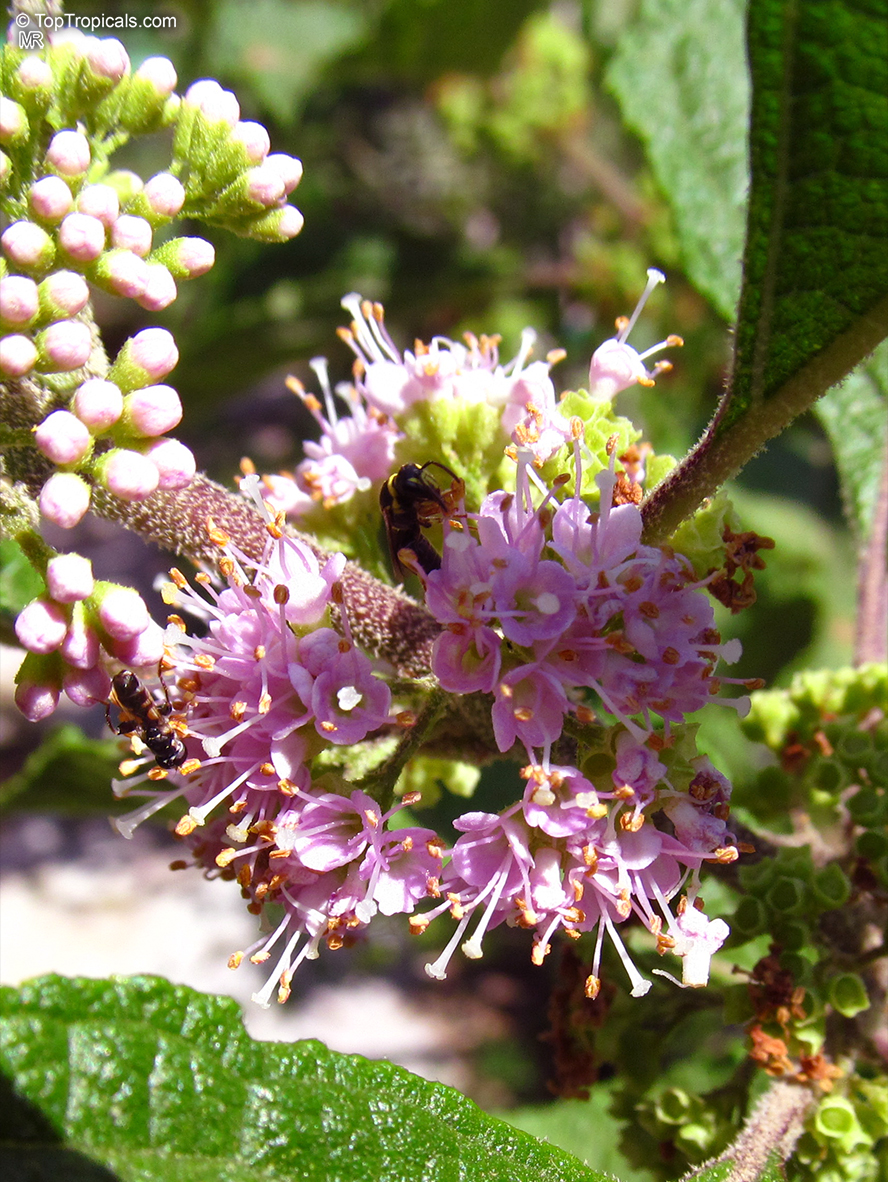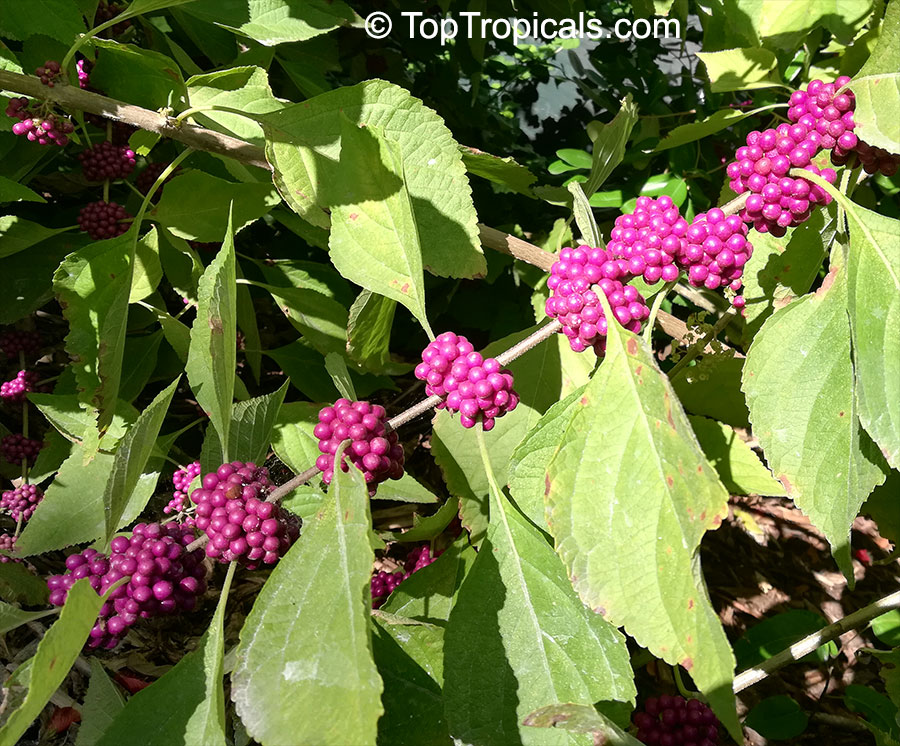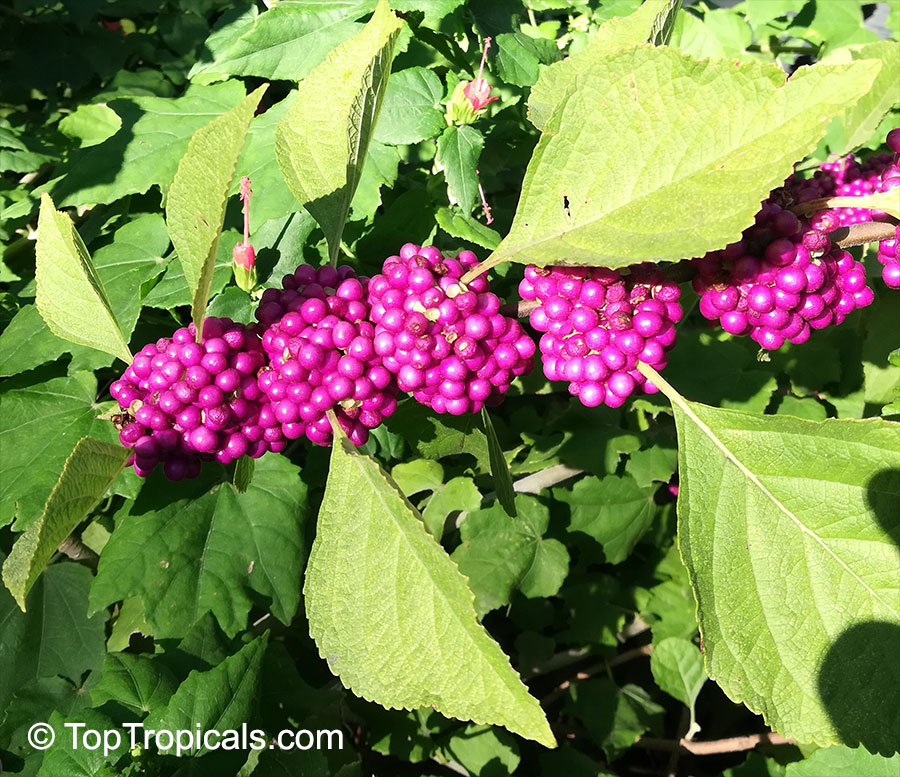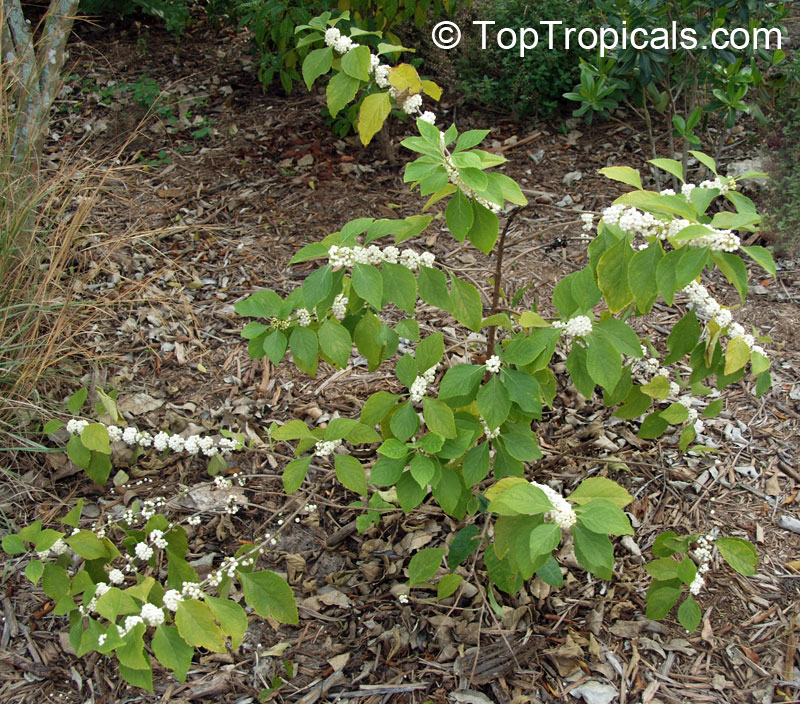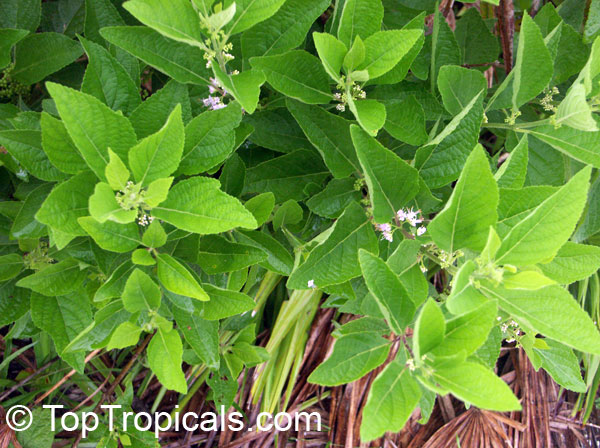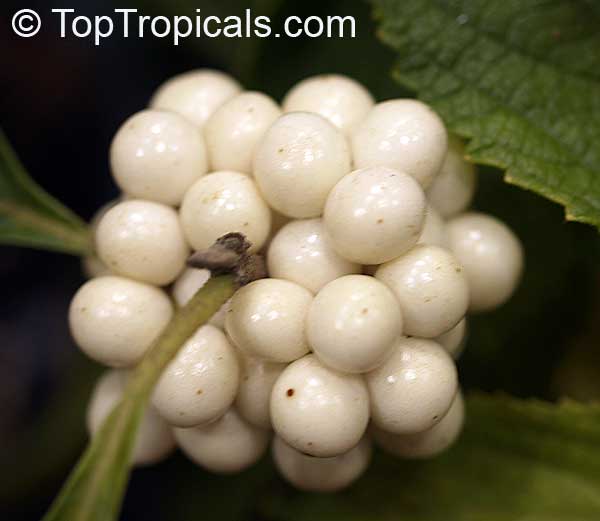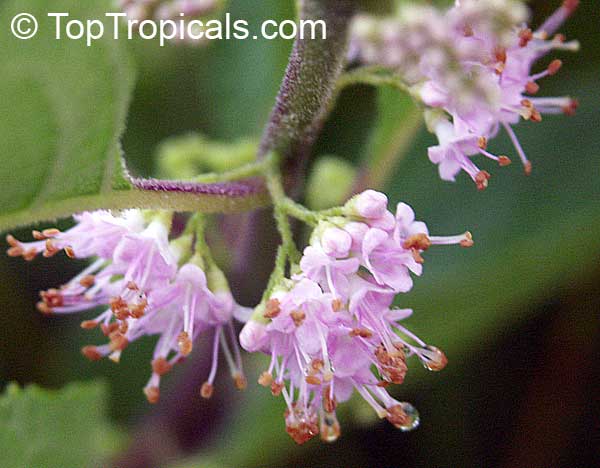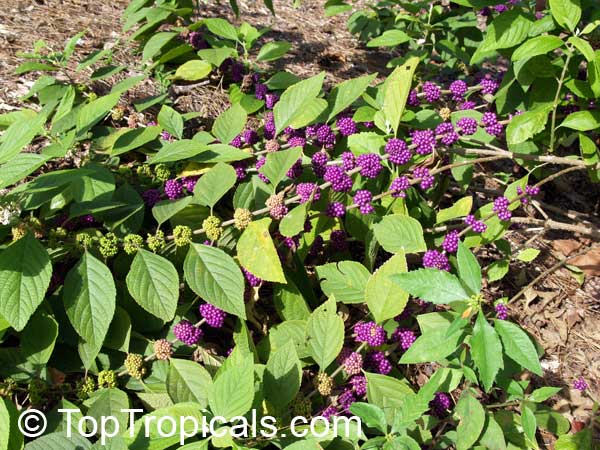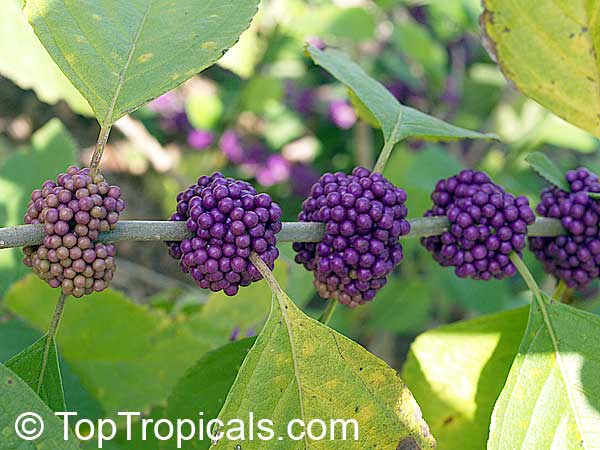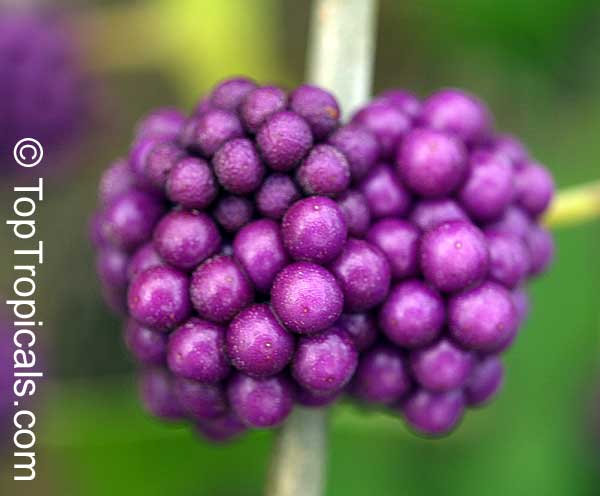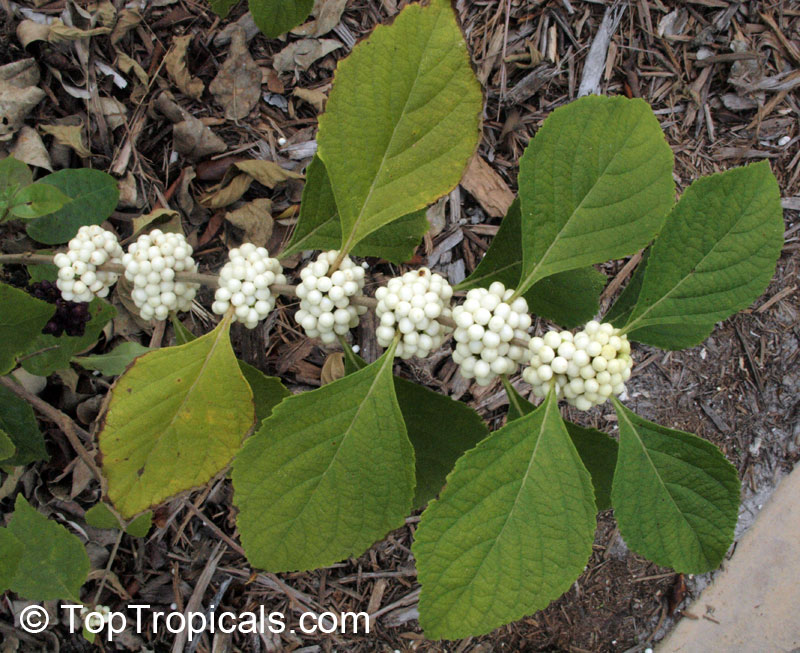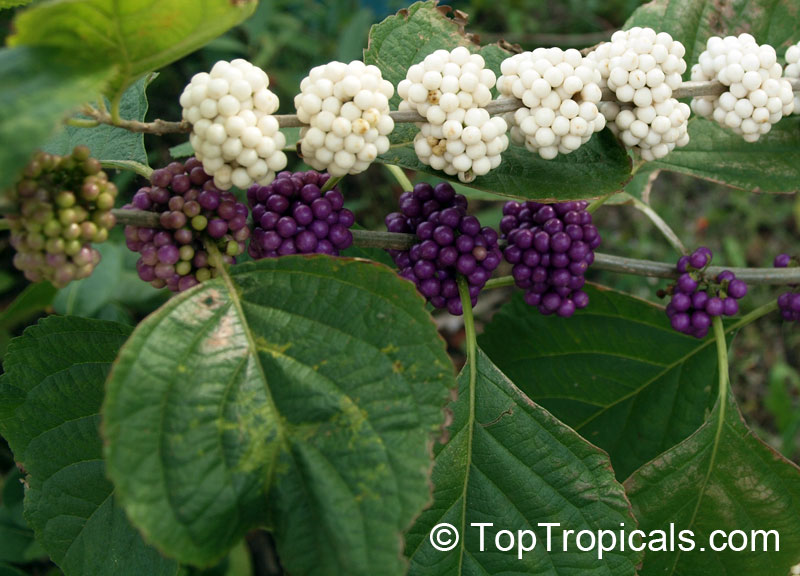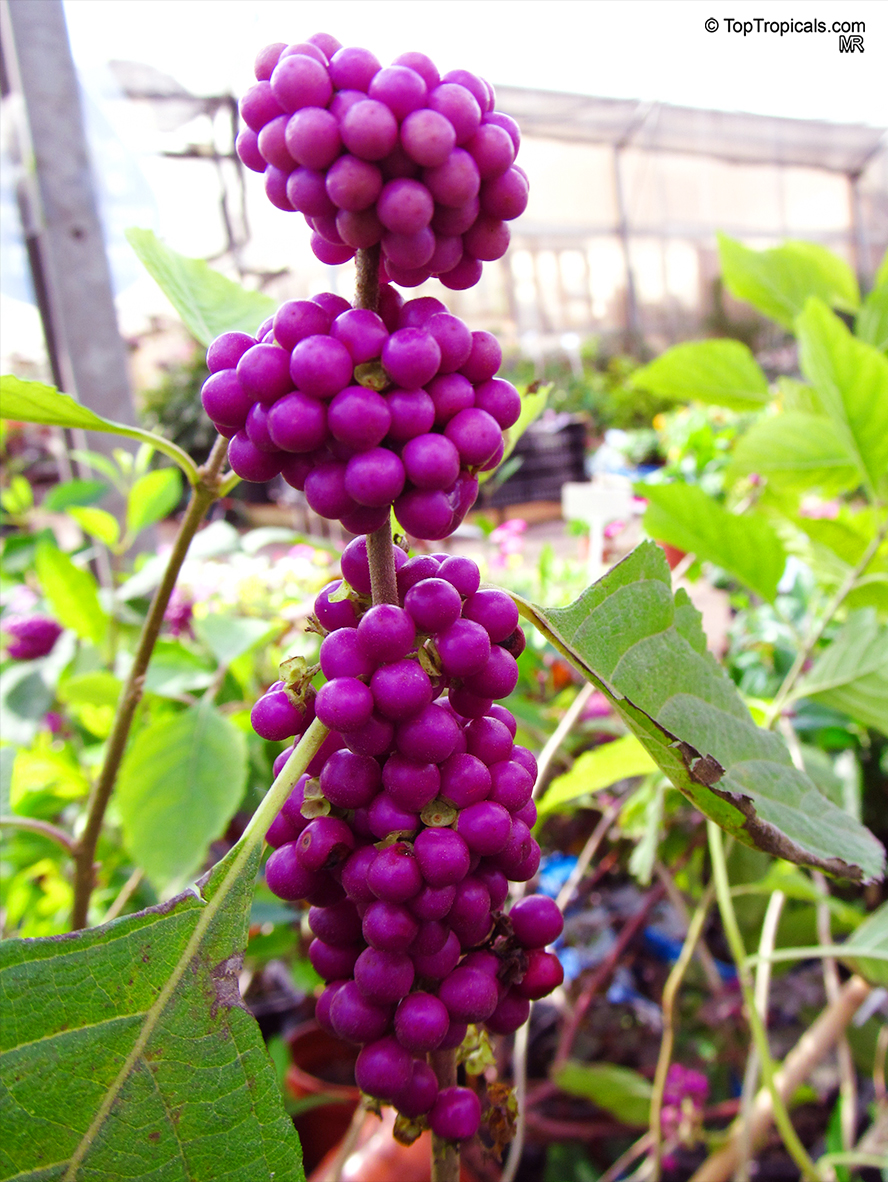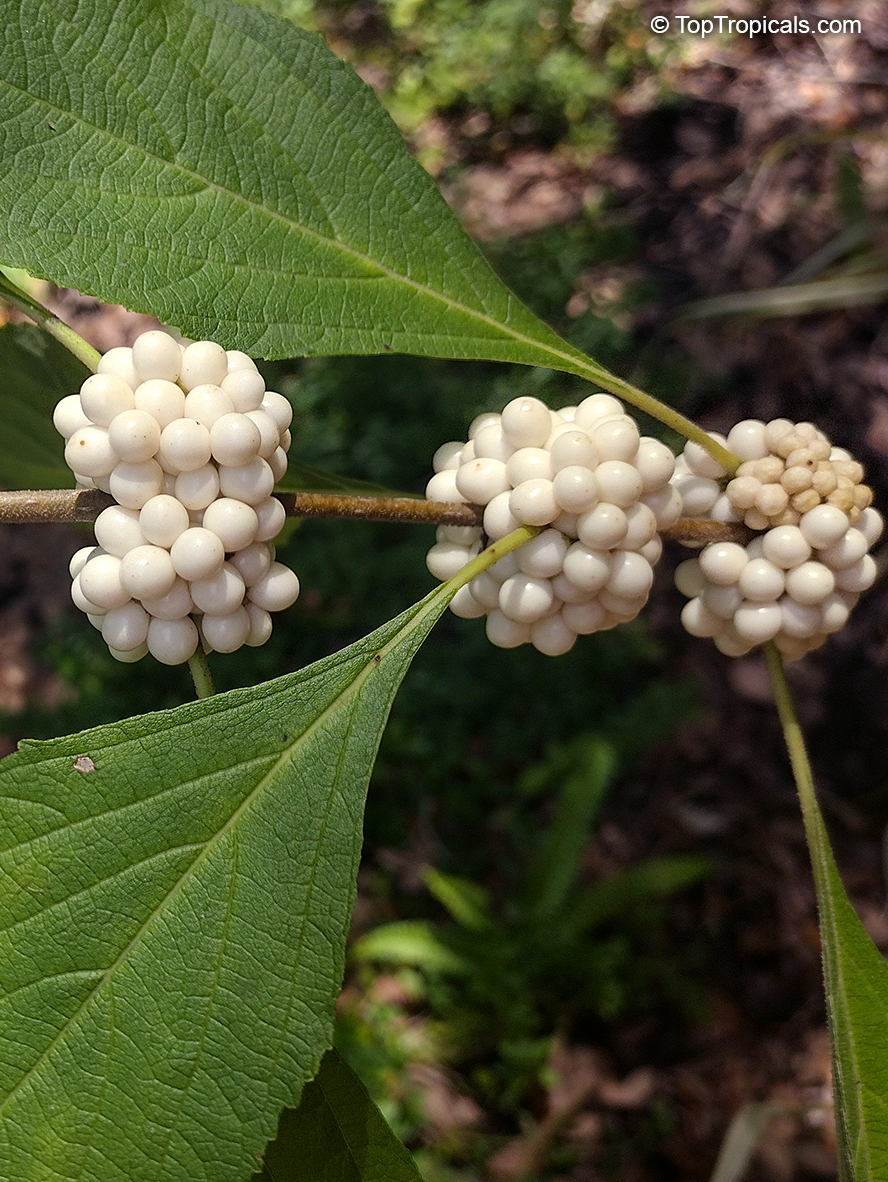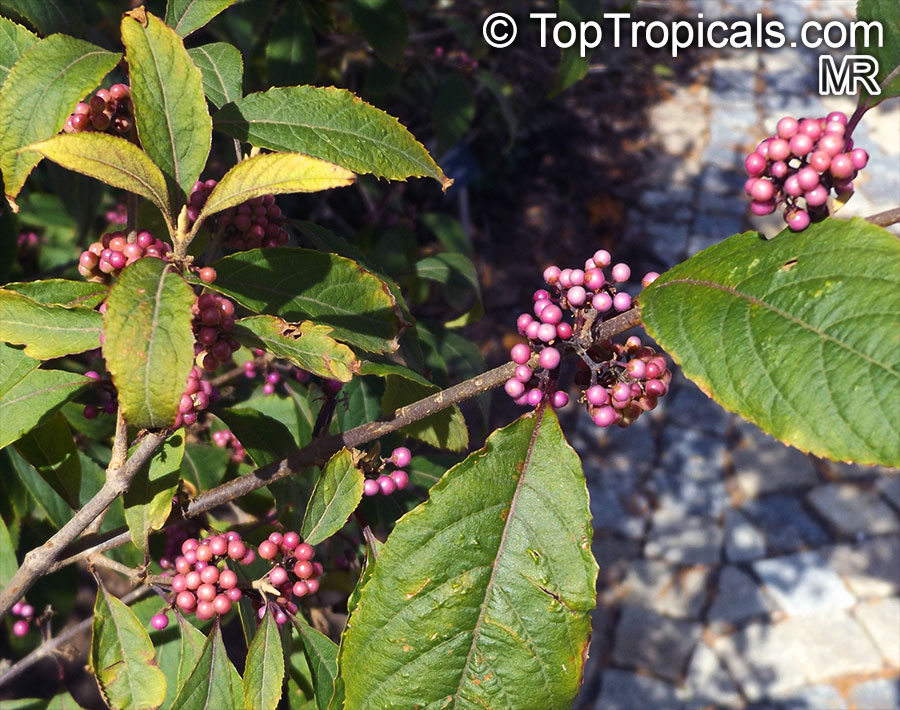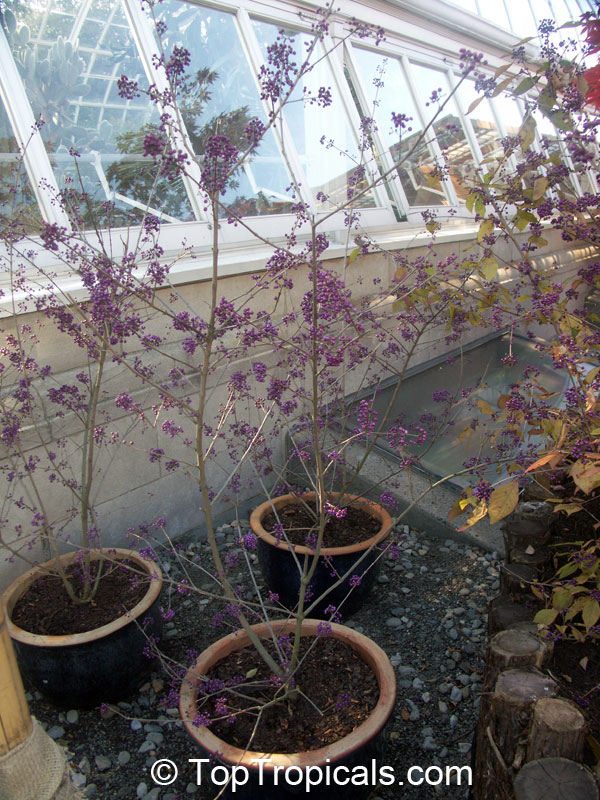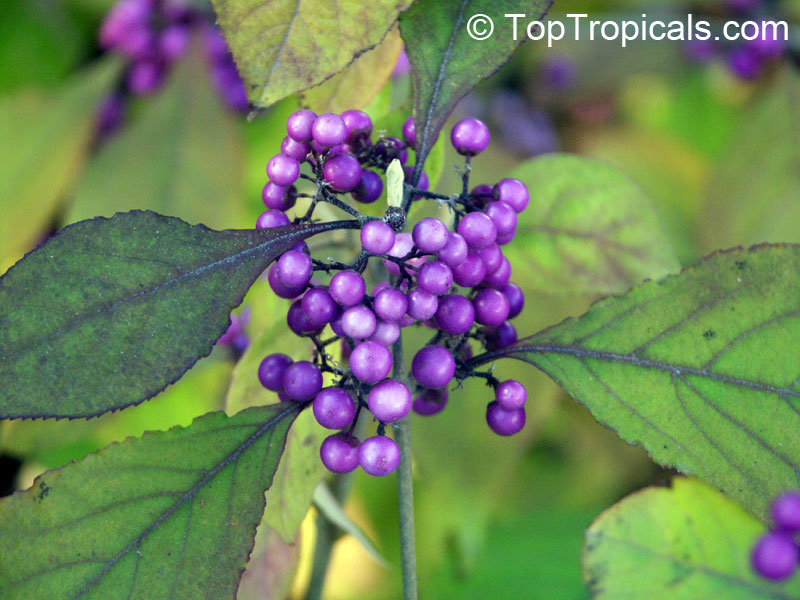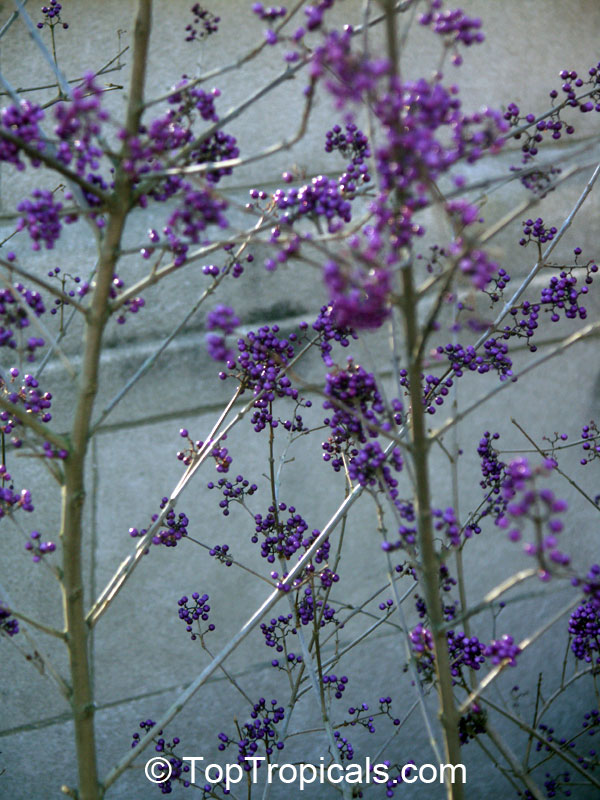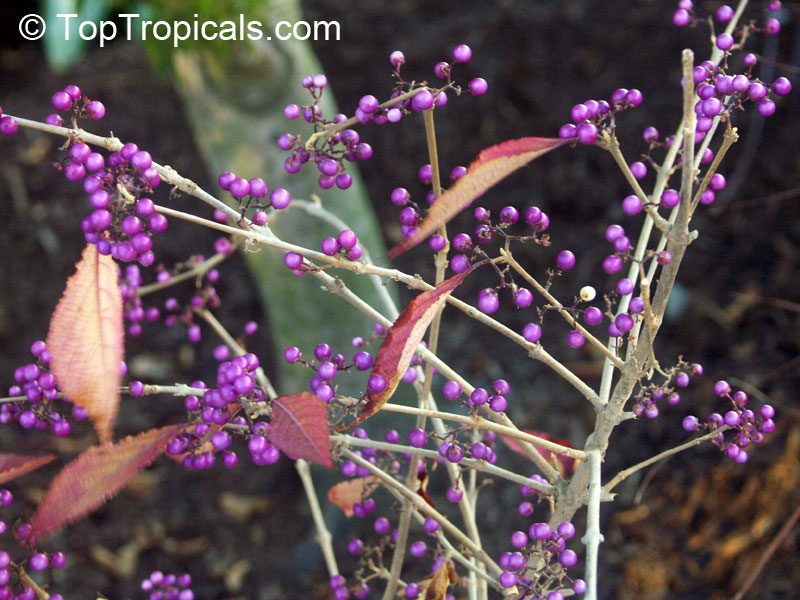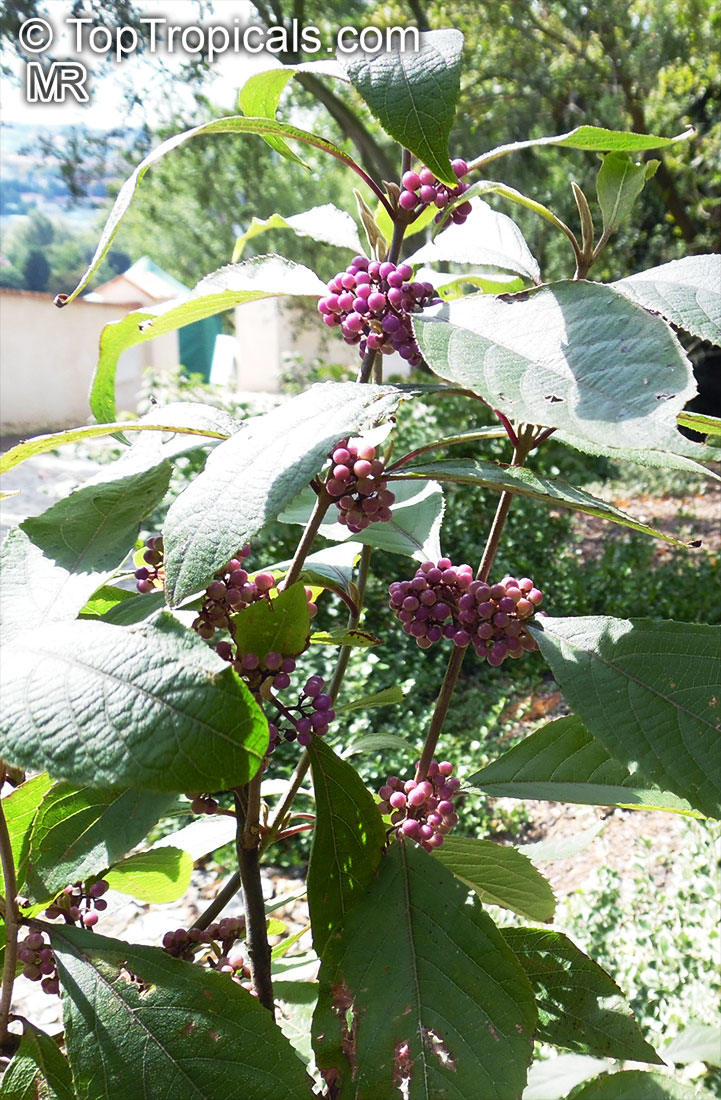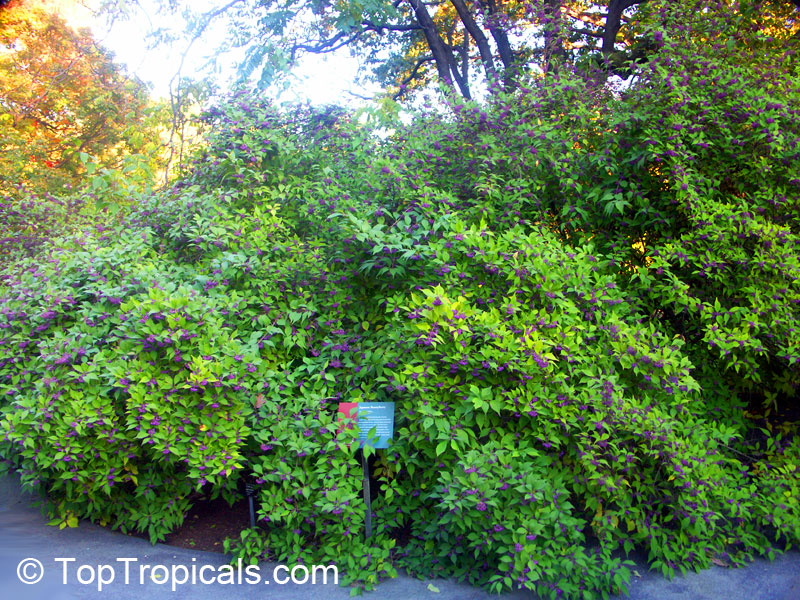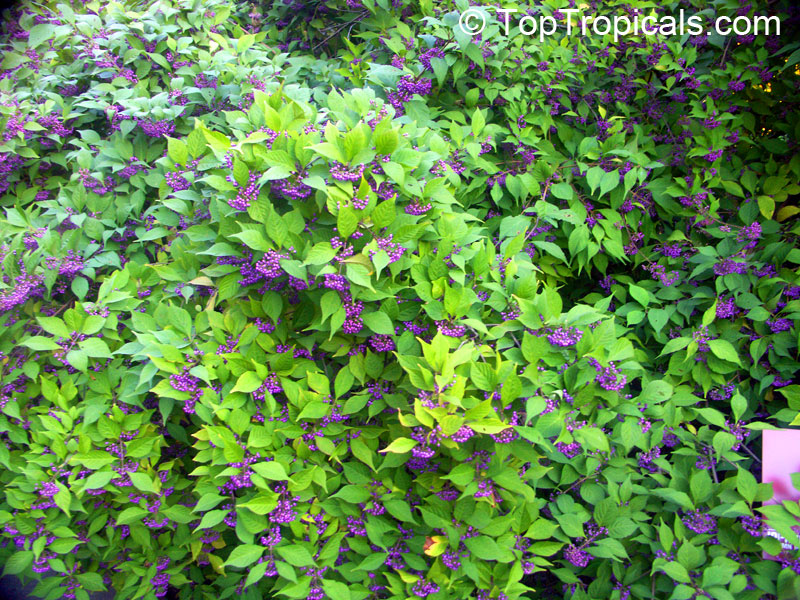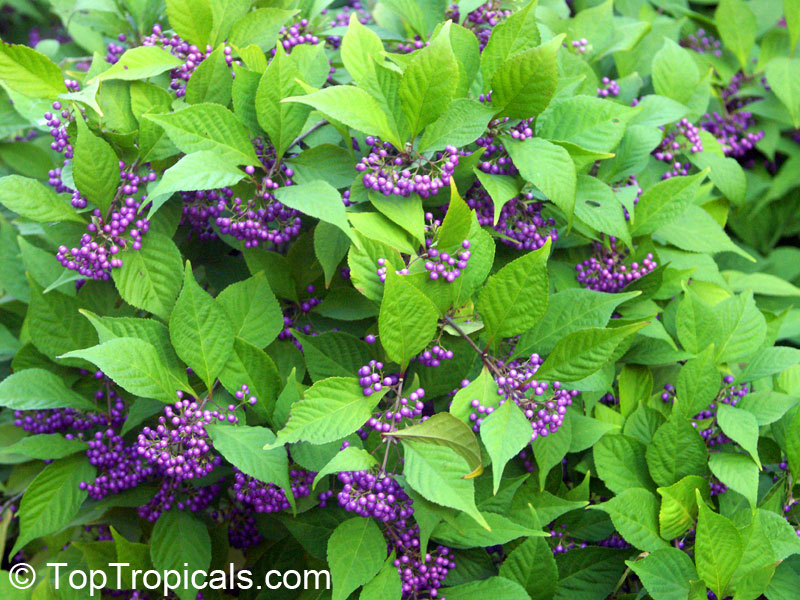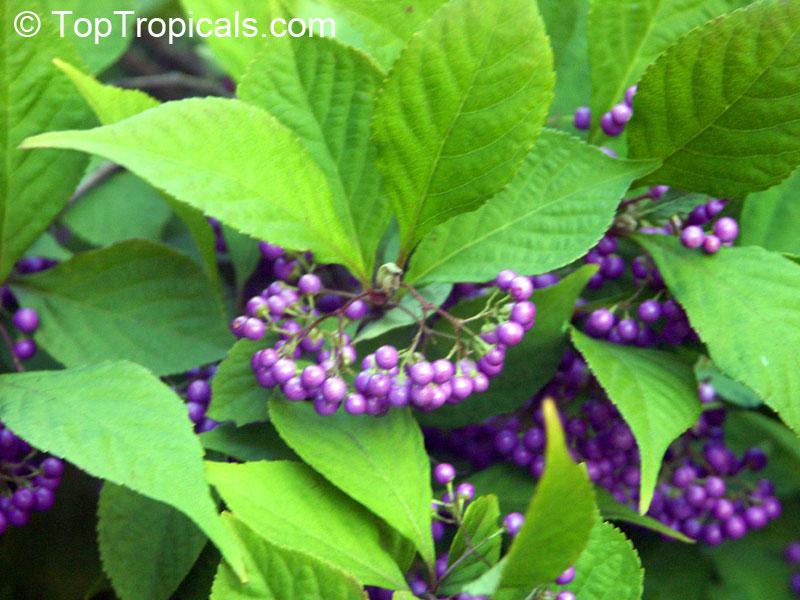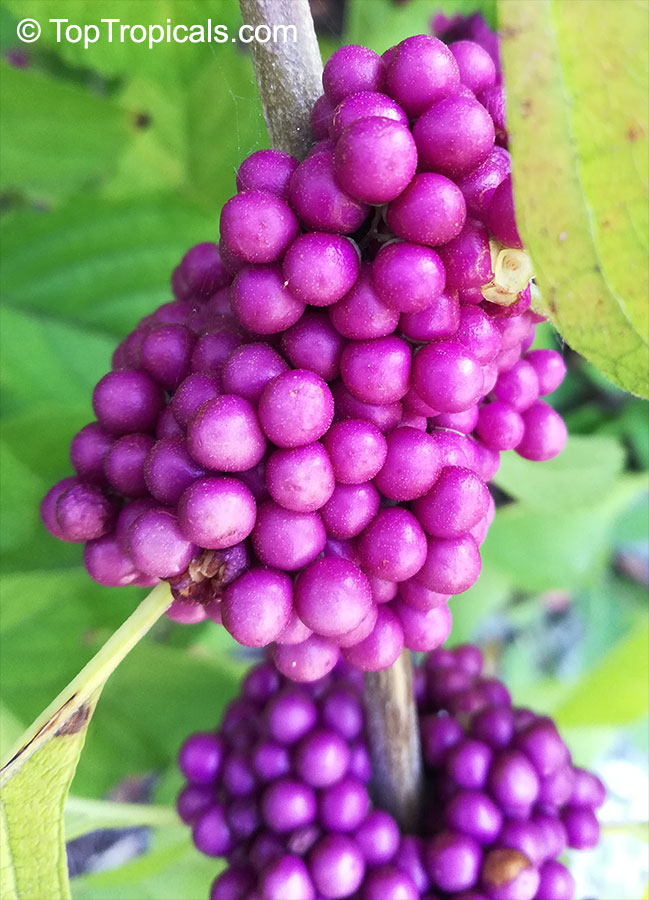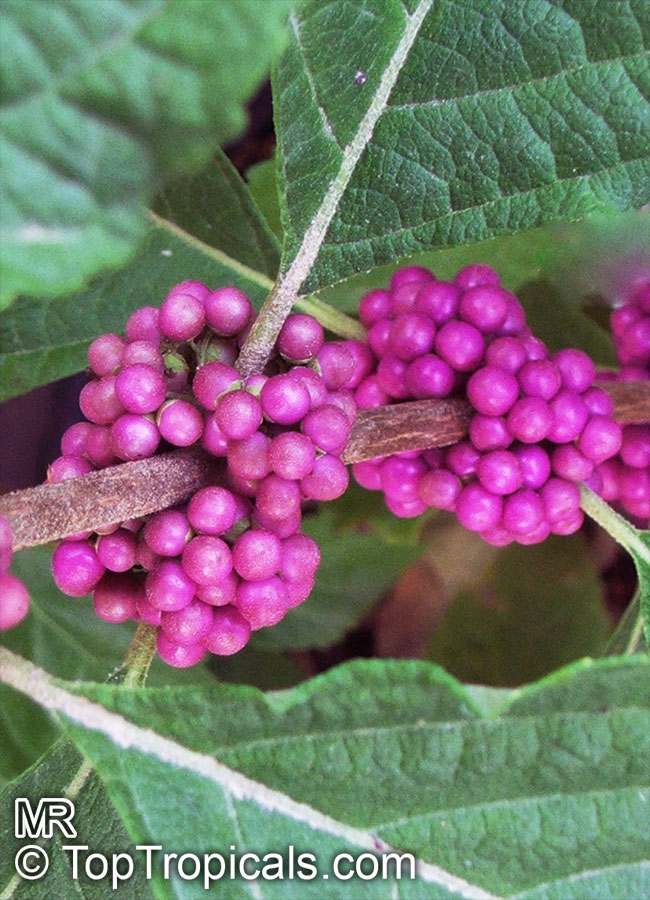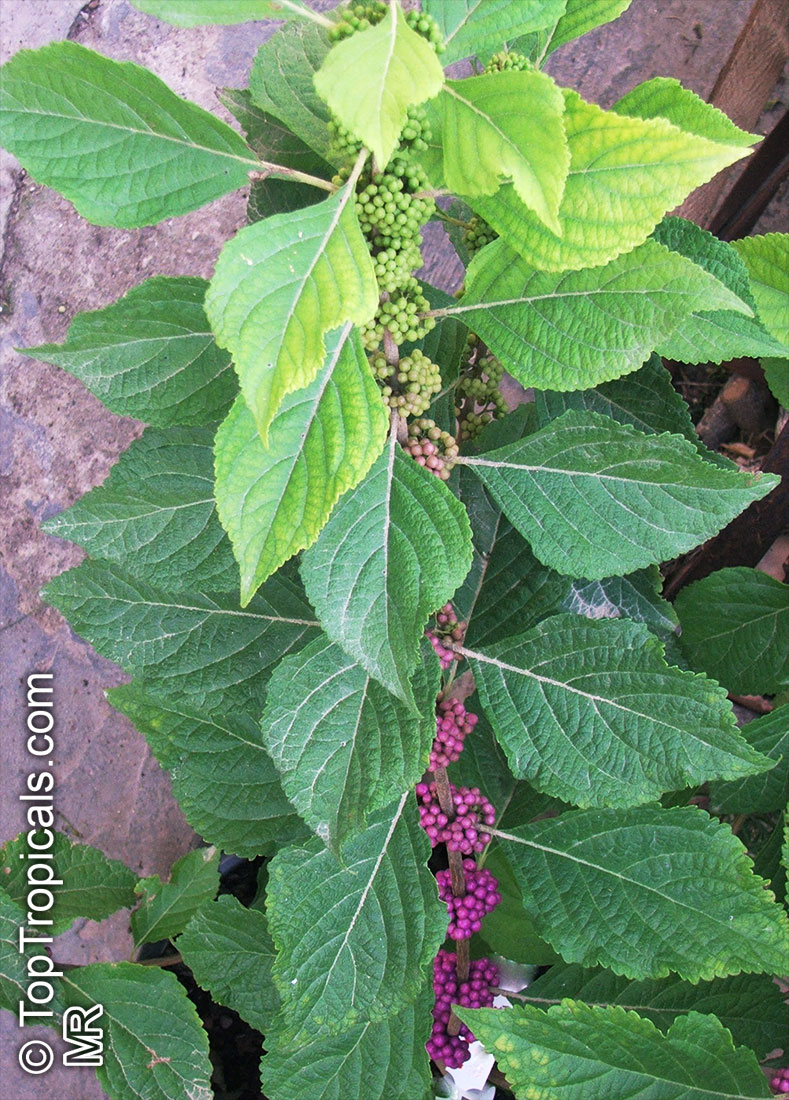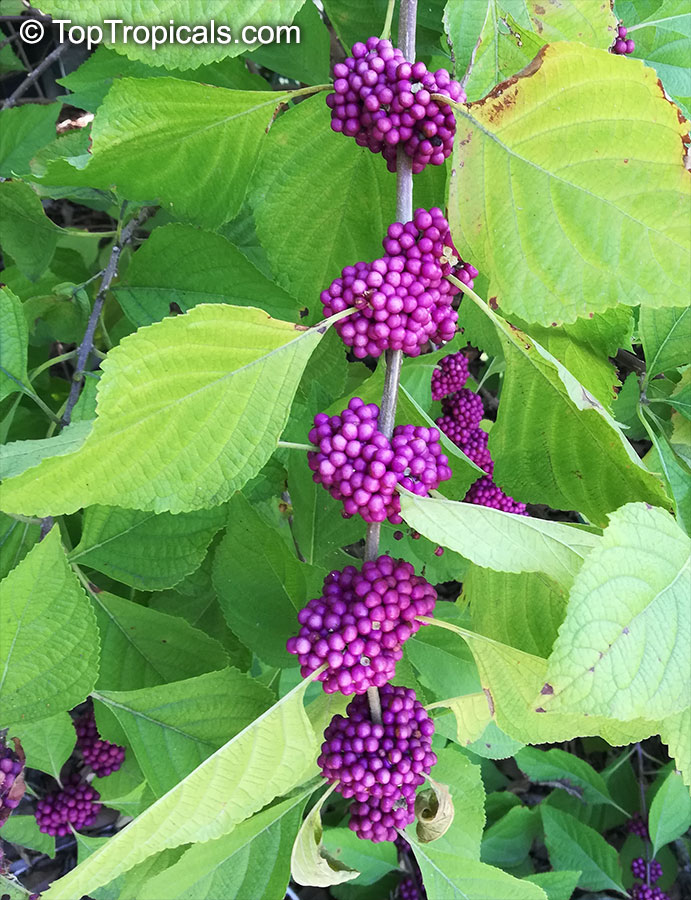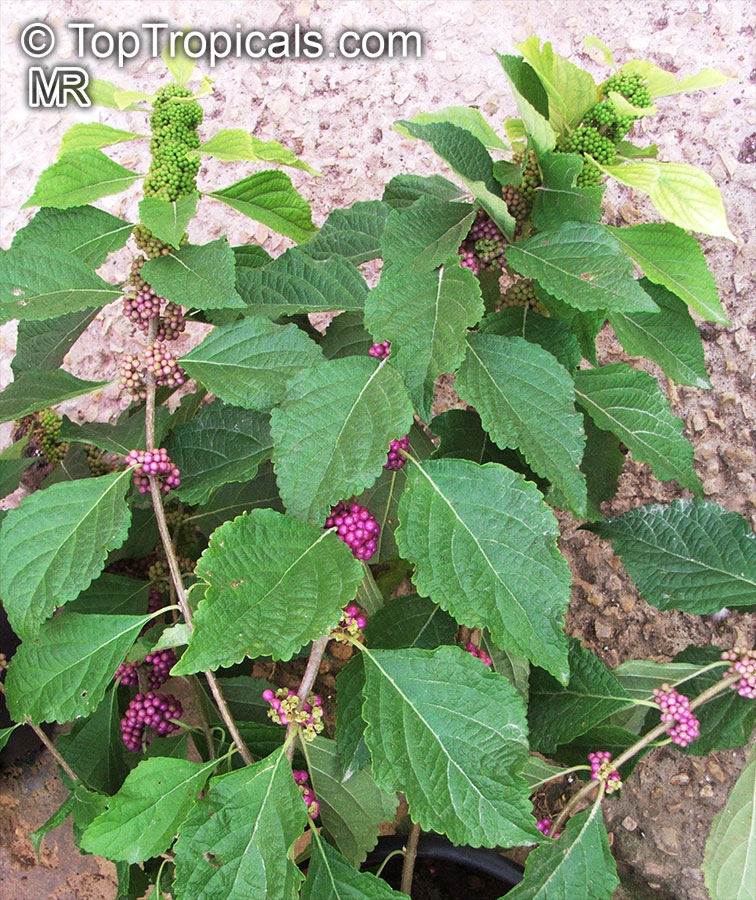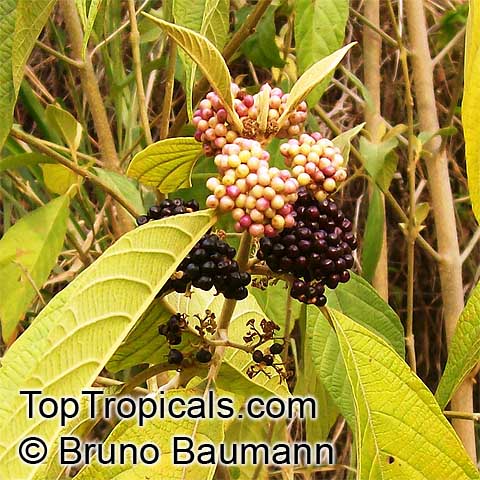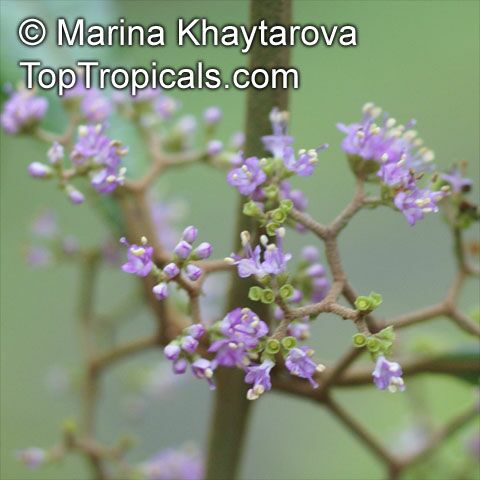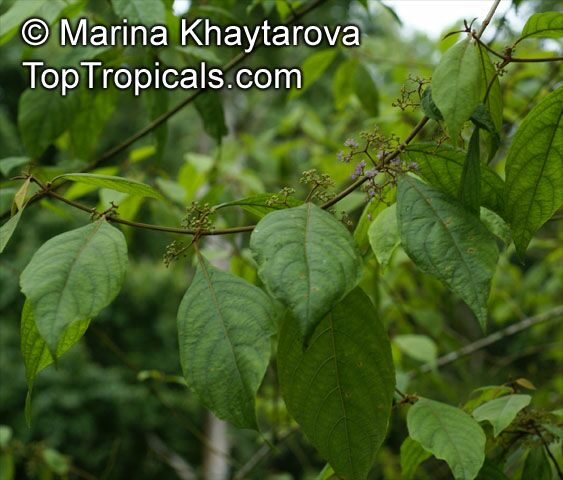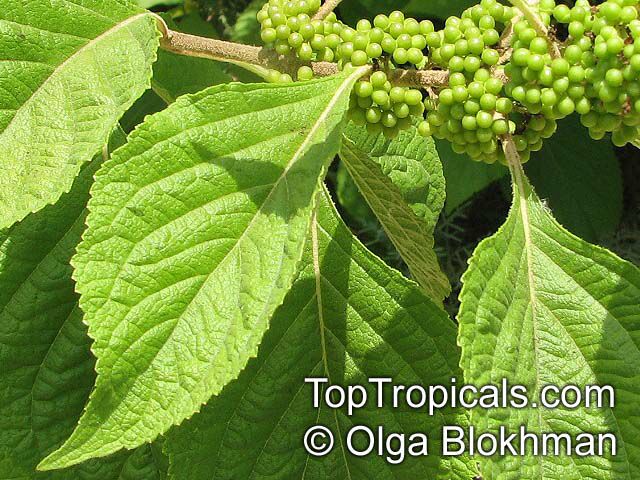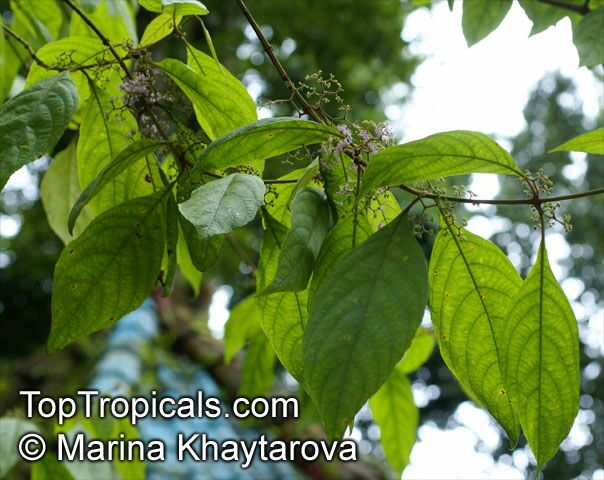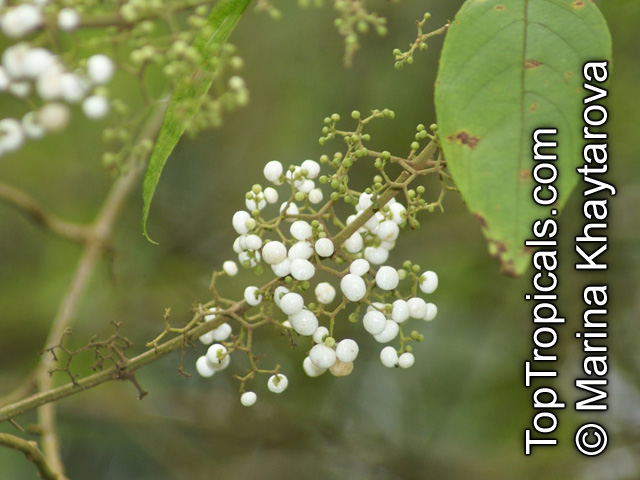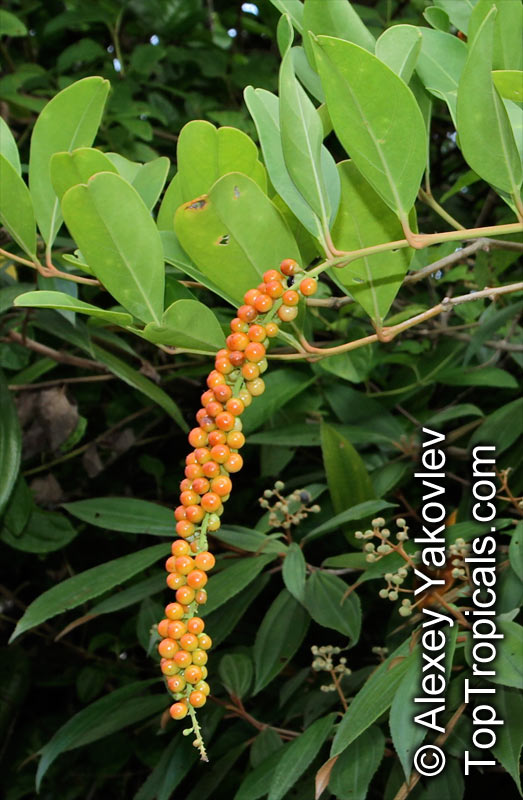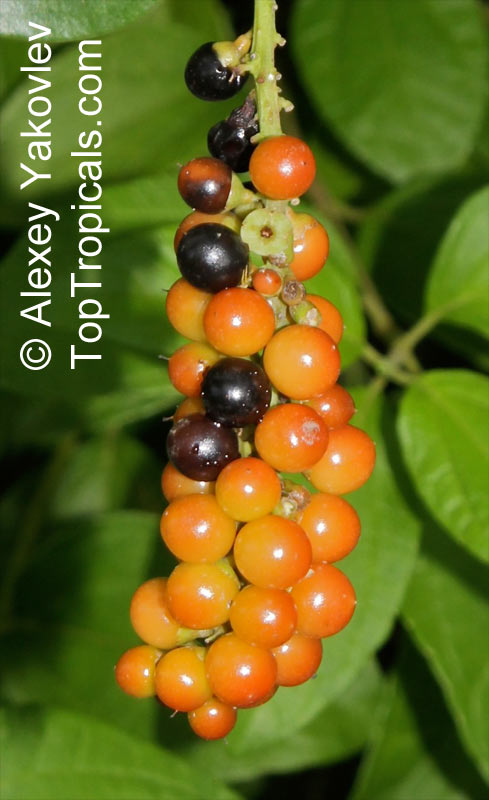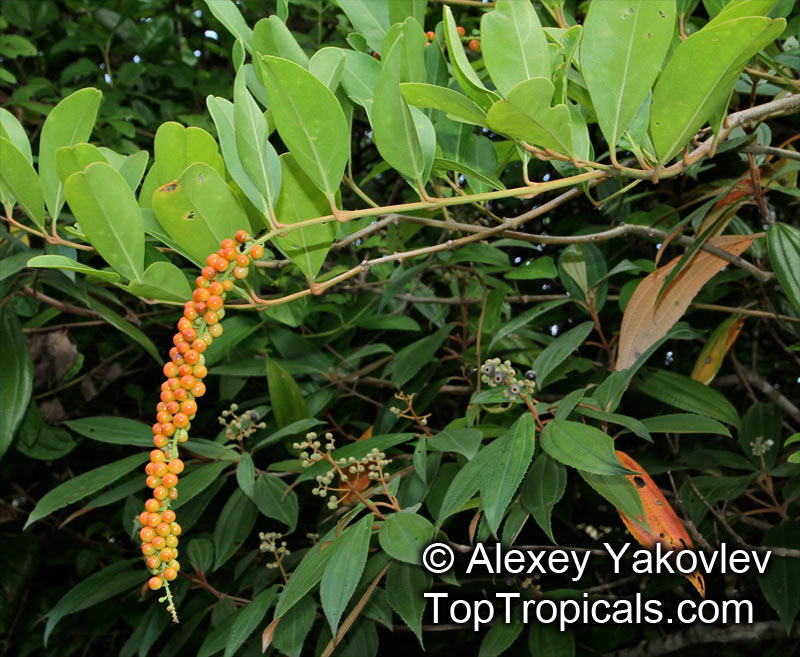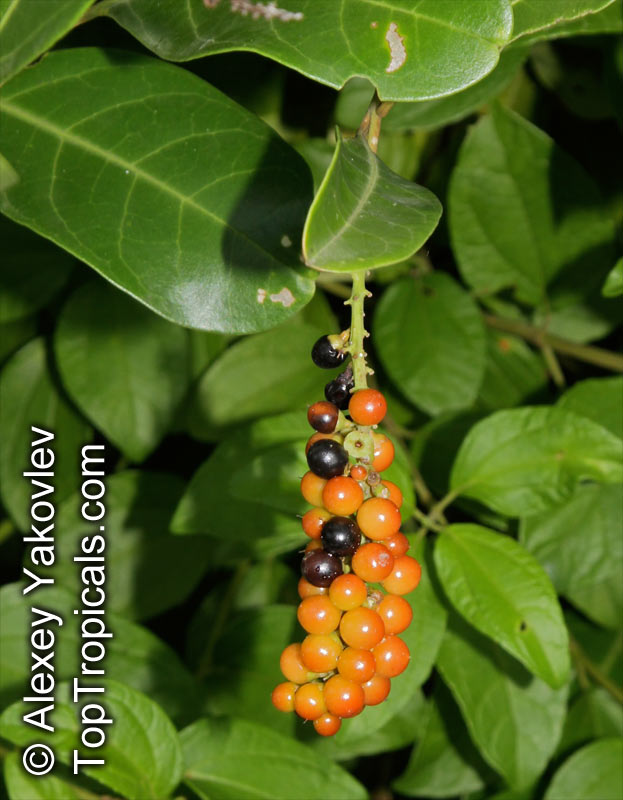Verbena - Plant Encyclopedia Results
Top Tropicals Plant Encyclopedia
| Number of plants found: 70 | Next | 
|
Go to page: | 1 | 2 | 3 | 4 | 5 | Last |
Botanical names: Lippia citriodora, Aloysia citriodora, Verbena citriodora, Verbena triphylla
Common names: Lemon-scented verbena, lemon Luisa, Pitiona
Family: Verbenaceae
Origin: South America (Chile and Peru)









Lemon verbena has an unusually pure, fruity lemon, note it is more intense than many other lemon-scented herbs. The genus name Aloysia, now also obsolescent, was allegedly given in honour of Maria Luisa Teresa de Parma (1751-1819), wife of king Carlos IV of Spain. The shrub can grow to 5 feet in height and has long narrow leaves which are highly scented smelling of lemon. It will bloom in late summer the flowers being tiny and white or lilac in color. Soil can be poor but needs a sheltered warm place and will need protecting during the cold weather. Lemon Verbena is an herbal medicine used to treat asthma, colds, fever, gas, stomach upset, and diarrhea. Lemon Verbena can be used in fruit dishes, jellies, punches, added to baked custard or home made ice cream. The leaves dry very well and can be used to make a mildly sedative tea. The leaves can also be put among linen and in pot-pourri, make an infusion of the leaves and add to your bath. An infusion is also said to be good for cleaning the teeth.
Botanical name: Nashia inaguensis
Common names: Moujean Tea, Bahamas Berry, Pineapple Verbena
Family: Verbenaceae
Origin: Caribbean










The Nashia inaguensis, also known as Moujean Tea, Bahamas Berry, or Pineapple Verbena, boasts delightfully fragrant leaves. This evergreen shrub hails from the island of Inagua in the Bahamas and is often cultivated as a bonsai due to its small size. During summer, it produces tiny white flowers in clusters that are followed by reddish orange berries. It thrives in full sun, warm temperatures, and high humidity, and requires consistent moisture to prevent drying out. Its fragrant leaves can be brewed into a tea that offers a citrusy, vanilla-like, or pineapple-like flavor and aroma.
This plant is an excellent choice for a small topiary or bonsai and makes a stunning centerpiece in Southern gardens. The plant has a low-growing habit of 2 feet, but can grow up to 5 feet when mature. It responds well to pruning and can be shaped and sized according to your preference. If planted along a walkway, the leaves can be lightly brushed to emit their enchanting scent with each passing.
Botanical name: Verbena sp.
Common name: Verbena
Family: Verbenaceae










Garden Verbenas are a large group of hybrids, with mainly Verbena peruviana and Verbena platensis in their parentage. They grow well in desert dry summer heat, they tend to get mildew in more humid weathers. They are good bedding and edge plant, in hot desert locations, they also make a good ground cover.
Botanical names: Aloysia gratissima, Lippia lycioides, Aloysia lycioides
Common names: Whitebrush, Beebrush
Family: Verbenaceae
Origin: Mexico, South America










Grown in full sun to partial shade, Aloysia gratissima is a large and moderately tolerant shrub native to Mexico and South America. It can grow up to 5-10 feet tall, producing fragrant white or off-white flowers with yellow and orange centers in the spring through fall. Attracting butterflies and hummingbirds, this ethnomedical plant is drought tolerant, low-water use, and tolerant of soils which are poorly drained.
It thrives in USDA Zones 8-11. In cold regions, Aloysia gratissima should be grown in a large enough pot to prevent it from freezing, and the pot should be brought inside during severe weather. Provide shade or mulch when temperatures dip too low, and be sure to water deeply after periods of extreme cold. Use a slow-release fertilizer to encourage healthy growth.
Botanical name: Aloysia virgata
Common names: Sweet Almond Bush, Incense Bush
Family: Verbenaceae
Origin: Mexico, South America








Aloysia virgata is very attractive to butterflies and hummingbirds. Native to Mexico and South America, Aloysia virgata (Sweet Almond Bush) is a large shrub that can reach heights of 5-10 feet tall. This plant prefers to be grown in full sun or semi-shade, with a moderate amount of water. Its fragrant, white to off-white flowers attract butterflies, hummingbirds, and other pollinators. It makes a great addition to any garden, with the bonus of a lovely scent.
Aloysia virgata is a fast-growing shrub, requiring very little care for best performance. In order to maintain its appearance and shape, it is important to prune it back periodically. It is also possible to grow it as a potted plant in cold regions, as long as the plant is given careful growing and care instructions.
For successfully growing Aloysia virgata in a pot in cold climates, the container must have good drainage to prevent waterlogging, and should be brought indoors when temperatures reach the mid 30s F. It is important to note that the pot should be large enough to accommodate the rate of growth of the plant. The soil must include compost or mulch for nutrients, and the soil should be kept consistently moist but not overly wet. During the winter, the soil needs to also be mulched to help ensure insulation from extreme cold temperatures.
Aloysia virgata is a beautiful and fragrant shrub that can provide near year-round beauty to any home garden. With proper care and maintenance, it can thrive in full sun or partial shade, and in a wide range of climates and soils.
Slender, densely branched deciduous shrub, 3 to 10 feet tall, 8 feet in spread. Fragrant foliage. White to yellow flowers appear in spring to fall with strong almond scent. attractive to butterflies and bees. This is a honey plant. Low water use, drought tolerant.
Recommended Fertilizer: SUNSHINE Megaflor - Bloom Nutrition Booster
Botanical name: Callicarpa americana
Common name: American Beautyberry
Family: Lamiaceae (Formerly:Verbenaceae)
Origin: North America






The beautyberries are packed tightly together in clusters that encircle the stem. Variety lactea has white fruits. Spring flowers and beautiful fall fruit make this an attractive landscape plant.
Very adaptable, even to low fertility soils. Very drought tolerant. Requires well drained soil. Propagation: Seeds and semi-hardwood cuttings.
Botanical name: Callicarpa bodinieri
Common name: Bodinier's Beautyberry
Family: Lamiaceae (Formerly:Verbenaceae)
Origin: West and Central China







The berries are edible and can be used in jams and jellies.
Callicarpa bodinieri is a large shrub, growing between 5-10 feet tall and wide. It is considered an easy to grow plant, requiring full sun and regular water, as well as occasional pruning of dead branches to maintain a neat shape. This deciduous plant is suitable for USDA Zone 6-10.
Callicarpa bodinieri produces beautiful pink flowers in mid to late summer, attracting butterflies and hummingbirds. In fall, the shrub is covered in clusters of small, purple berries, making it an attractive addition to the garden.
When growing Callicarpa bodinieri in pots, it is important to provide a well-draining potting mix, and to ensure that the plant is not overwatered.
Botanical name: Callicarpa japonica
Common names: Japanese Beautyberry, Murasaki Shikibu
Family: Lamiaceae (Formerly:Verbenaceae)
Origin: Japan








Botanical name: Callicarpa sp.
Common name: Beautyberry
Family: Lamiaceae (Formerly:Verbenaceae)








Callicarpa sp. (Beautyberry) is a large shrub, usually growing 5-10 feet tall and wide. It is native to temperate and tropical regions, and its adaptability to various environments makes it a popular landscape plant. This deciduous plant produces clusters of small, star-shaped pink flowers in early summer, followed by eye-catching clusters of bright purple berries in the late fall and winter.
For best results, Beautyberry needs full sun or partial shade, and regular to moderate water. Given the right conditions, Beautyberry can offer a richly colored, lush presence to any garden. In cold regions, where this plant is not winter hardy, beautyberry can be grown in a pot and brought indoors during the coldest months.
In terms of temperature, Beautyberry is a surprisingly hardy plant for its size and delicate appearance. The USDA Plant Hardiness Zone for Beautyberry is 5-8. Despite its winter hardiness, Beautyberry may require protection from heavy winter rains and winds.
Botanical name: Citharexylum caudatum
Common names: Juniper Berry, Fiddlewood
Family: Verbenaceae
Origin: Central America, Mexico









Citharexylum caudatum, commonly known as Juniper Berry, is a native to Central America and Mexico. This large shrub or small tree grows to 5-10 ft tall with moderate water requirements and will thrive in semi-shade or full sun. The glossy green foliage creates a great contrast to the fragrant off-white flowers which will attract butterflies and hummingbirds. The plant blooms from spring to late fall, creating an enchanting landscape.
This beautiful plant is easy to care for in USDA Zones 9-11, as they're not very picky about soil conditions. They enjoy regular watering throughout the growing season, but can tolerate times of drought better than times of excess water.
For those that live in cold regions, Citharexylum caudatum can easily be grown in a pot and sheltered indoors during the winter. The pot should be kept in a warm spot, preferably near a window, to ensure the best environment for the Juniper Berry's growth.
Overall, the Citharexylum caudatum is an easy to care for and attractive plant that will enhance any yard or garden. Its fragrant flowers and evergreen foliage creates a delightful landscape and its ability to attract butterflies and hummingbirds provides a wonderful addition to any outdoor space.
| Next |  |
Use link to repeat this search:
https://toptropicals.com/cgi-bin/garden_catalog/cat.cgi?find=Verbena&search_op=and&keyword_op=and&language=e&number=10
&no_change_lang=1&user=tt&sale=1&first=0
